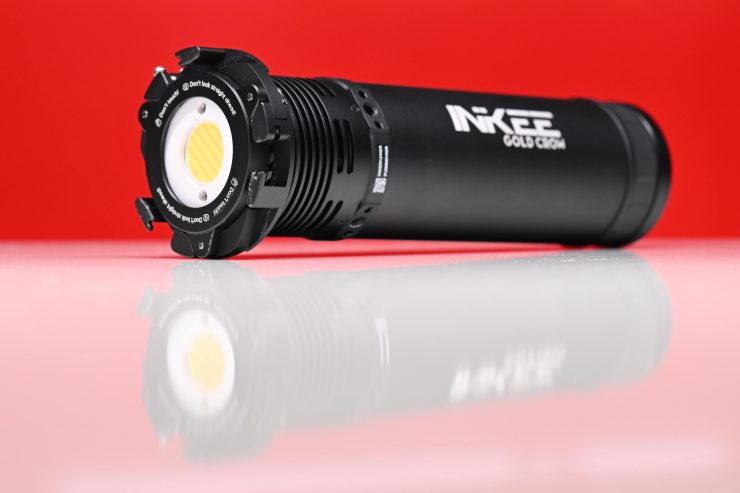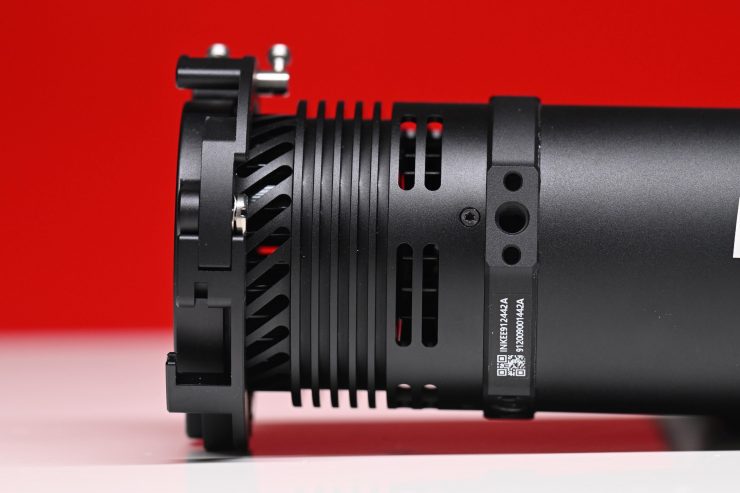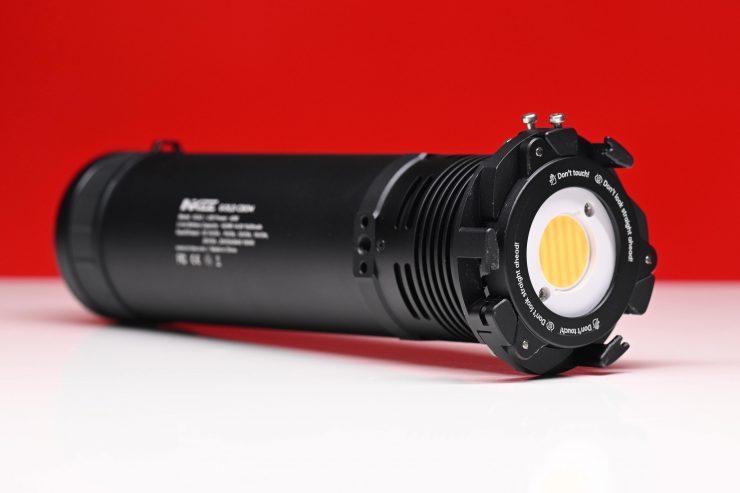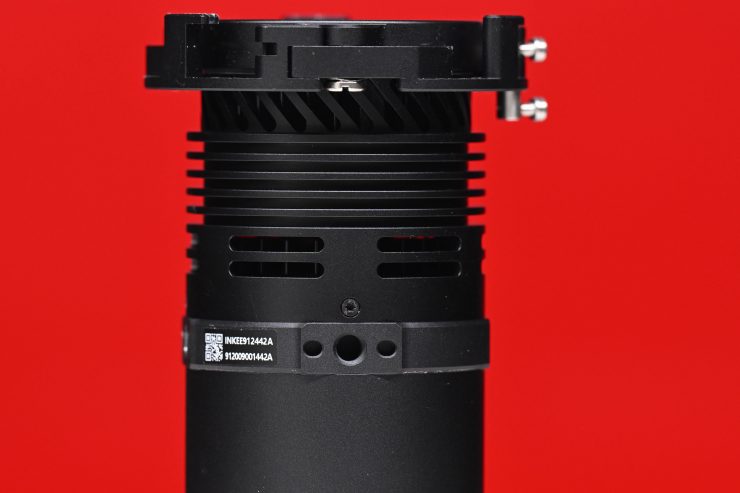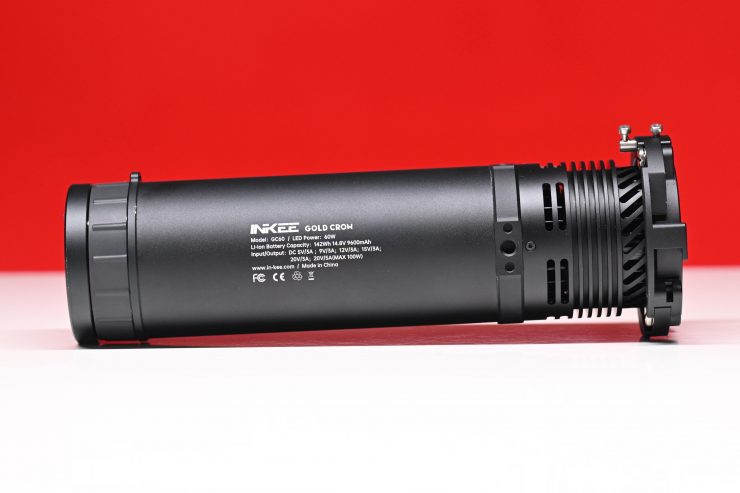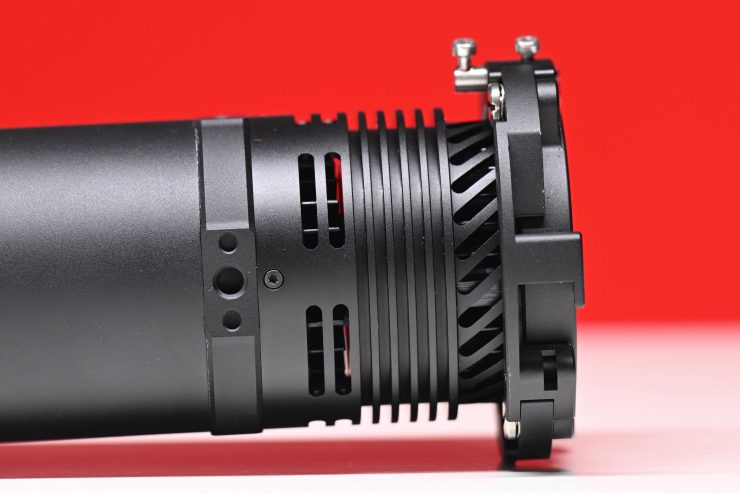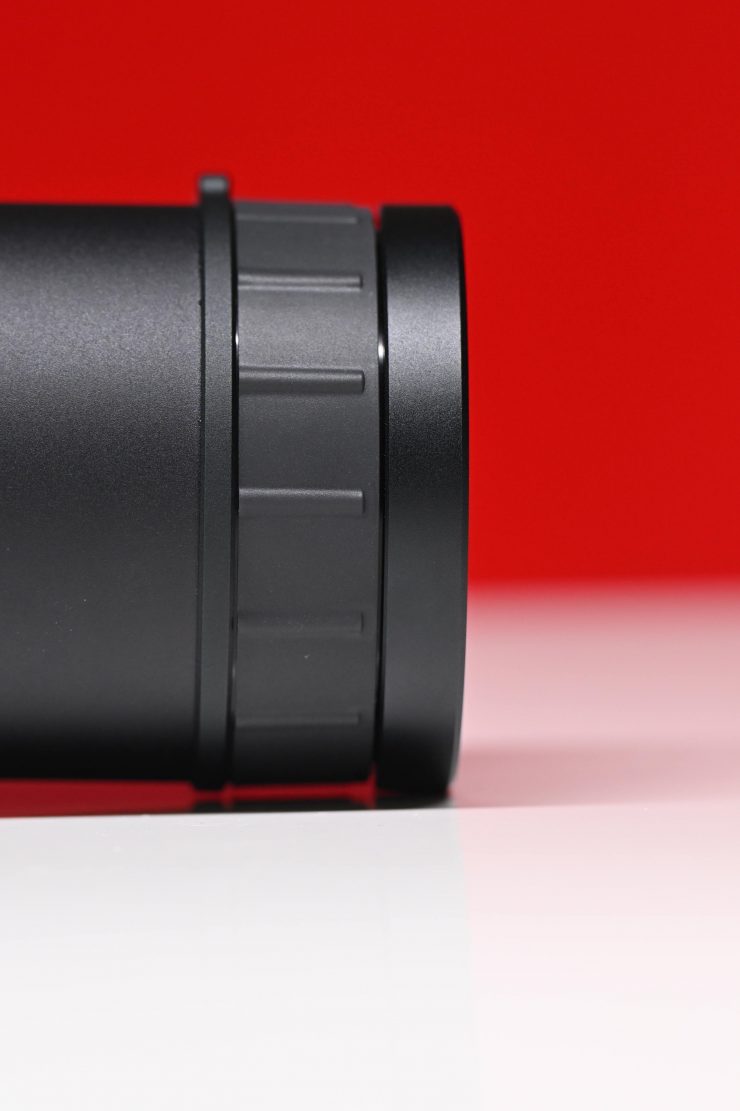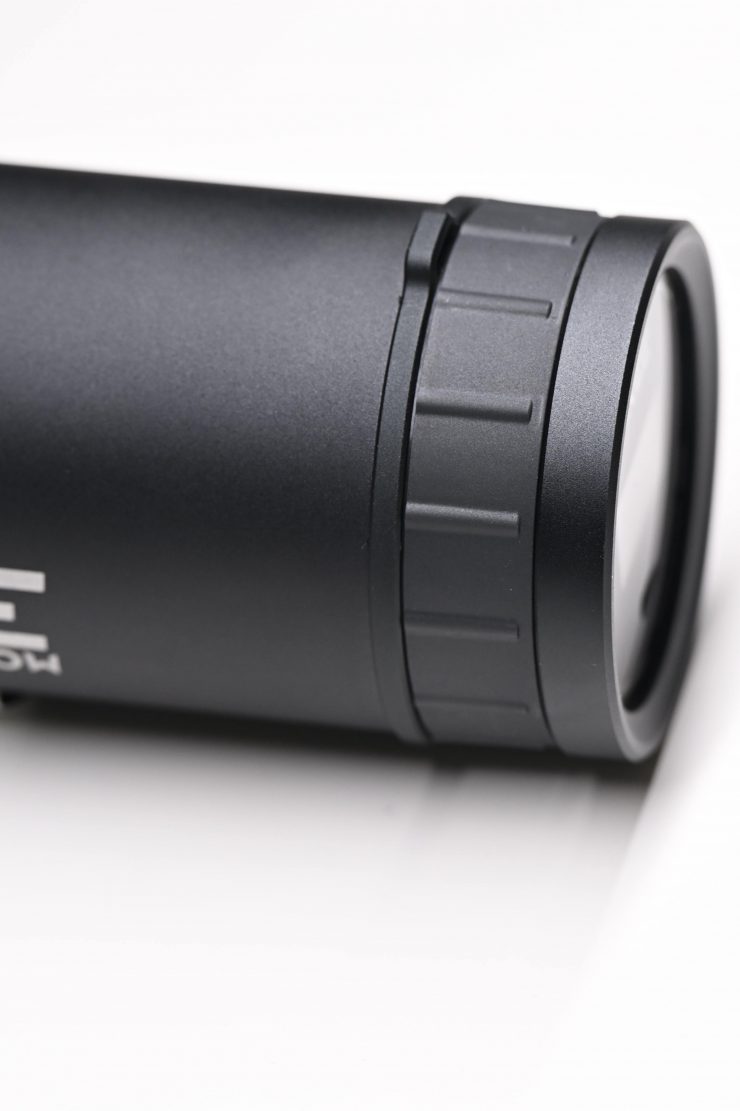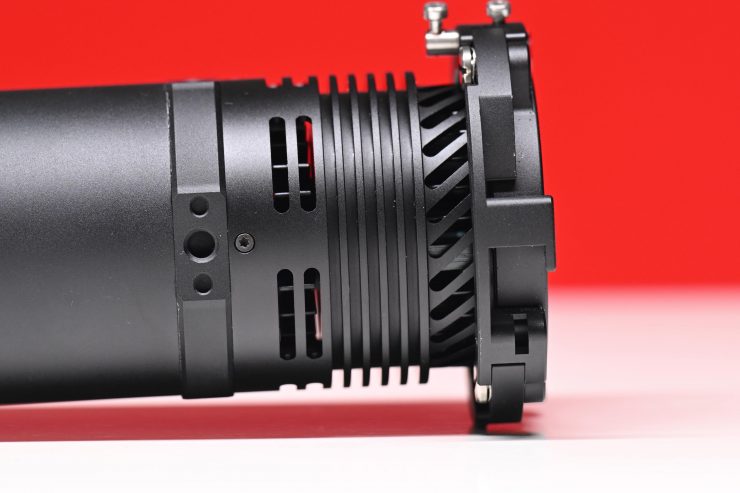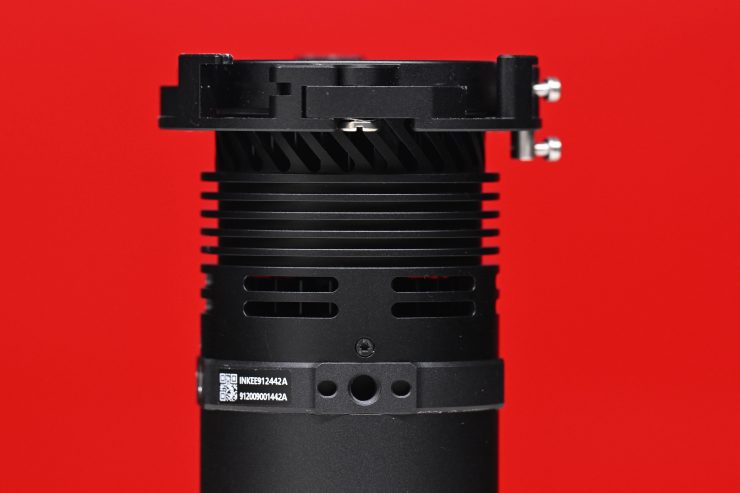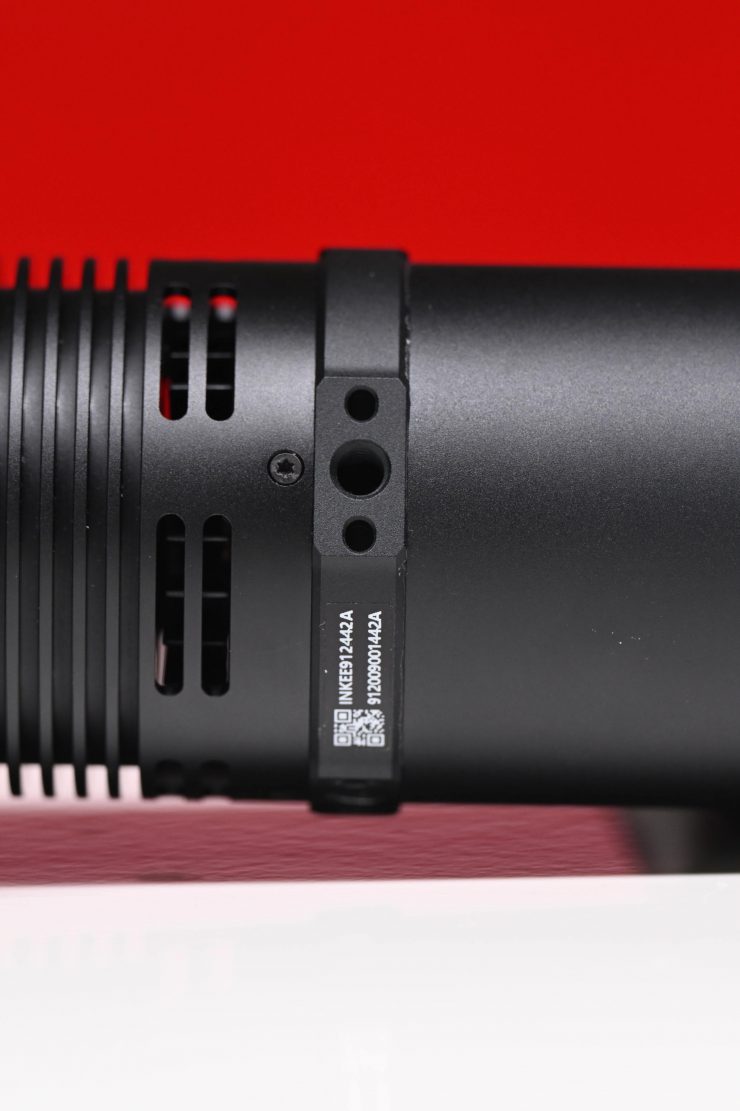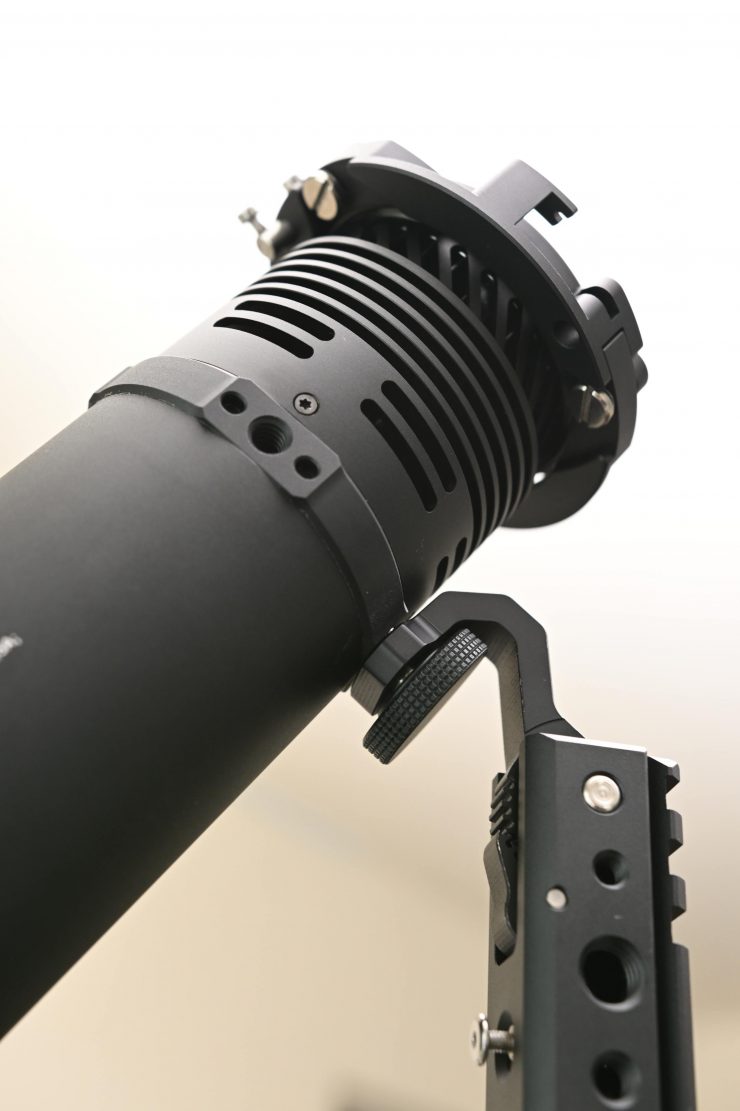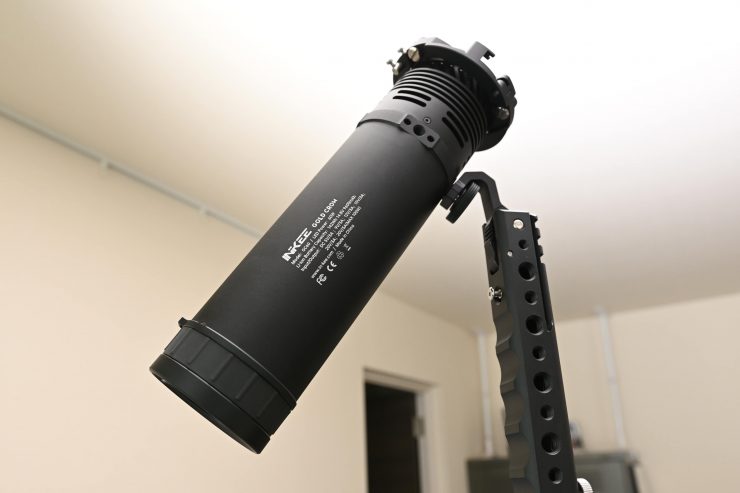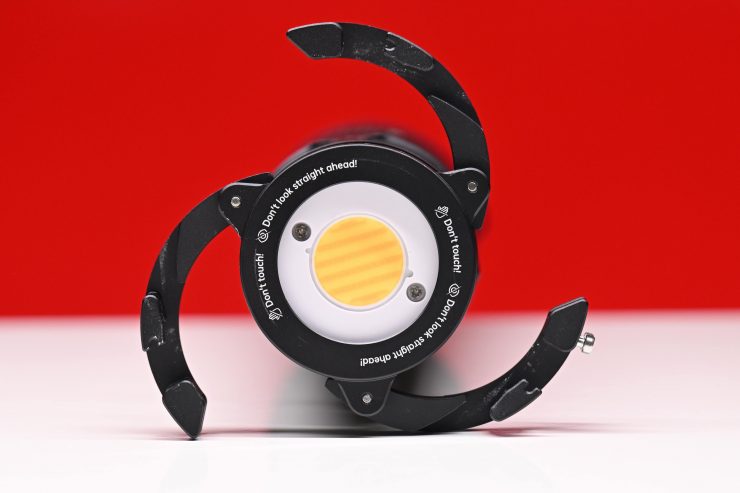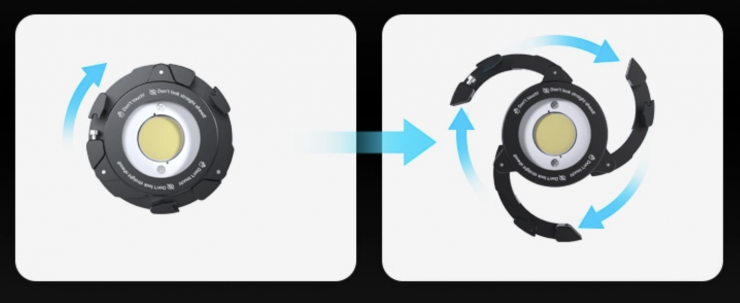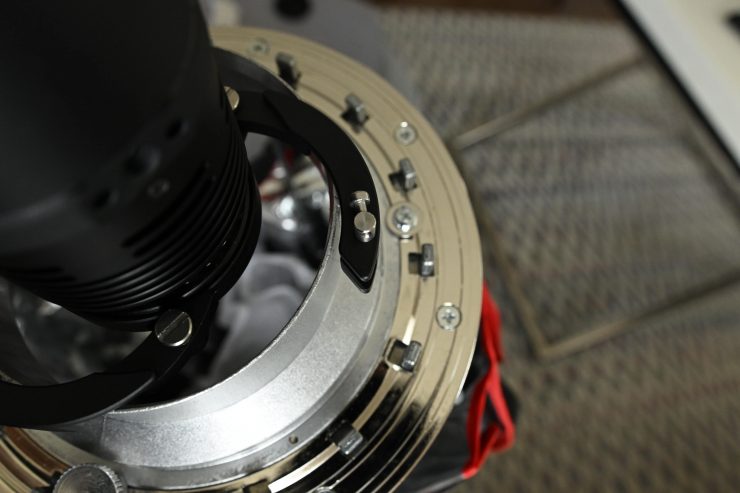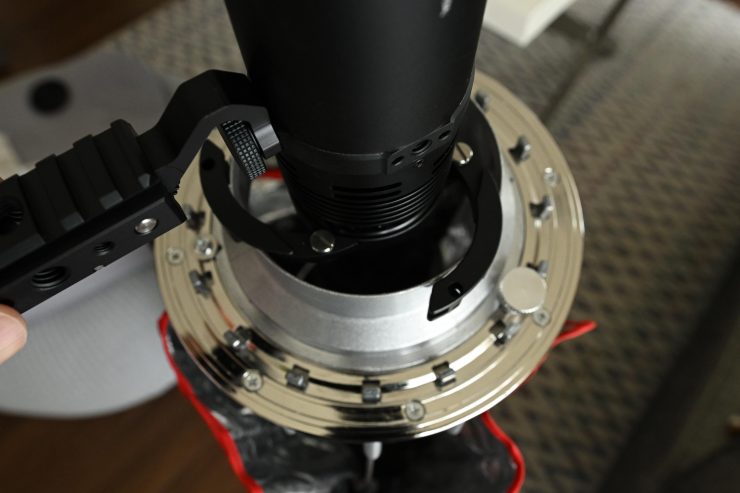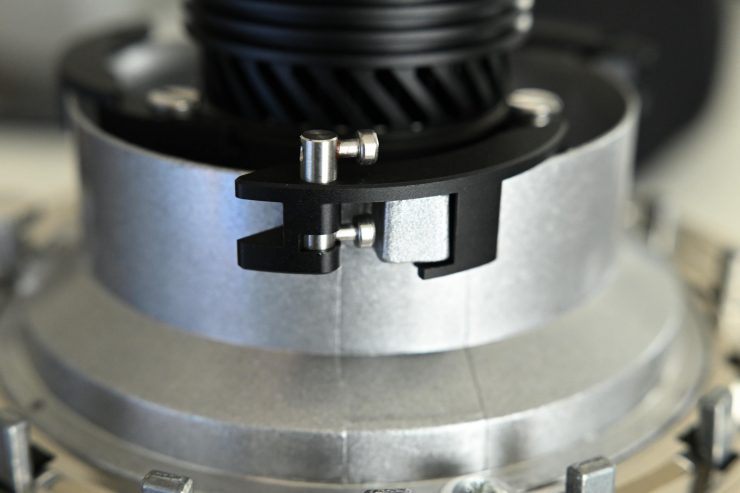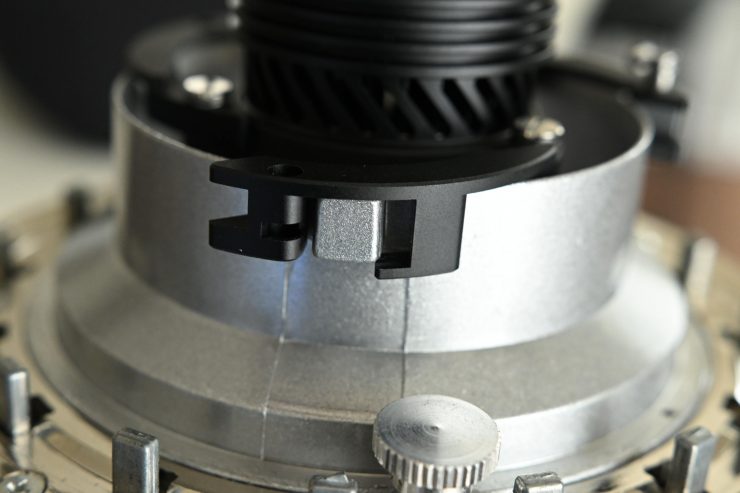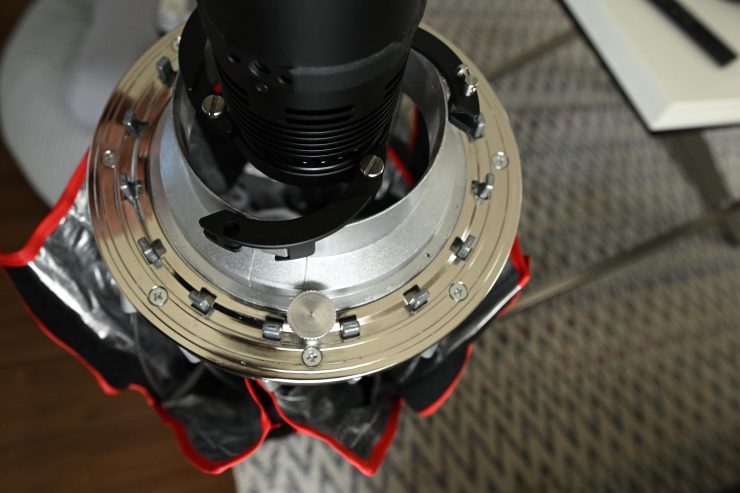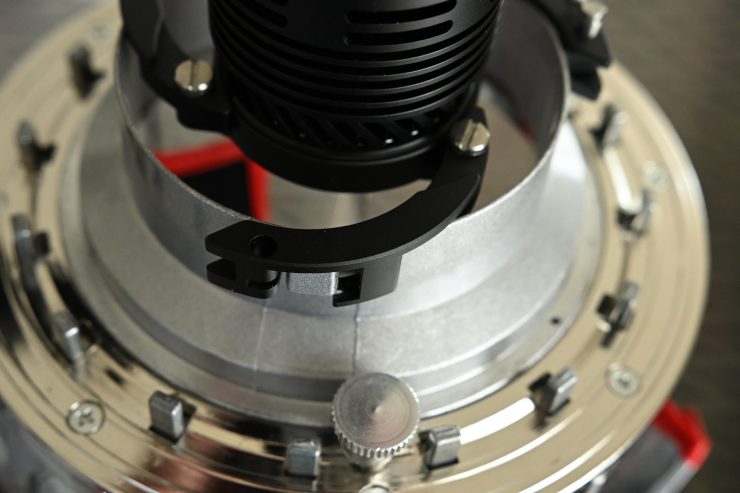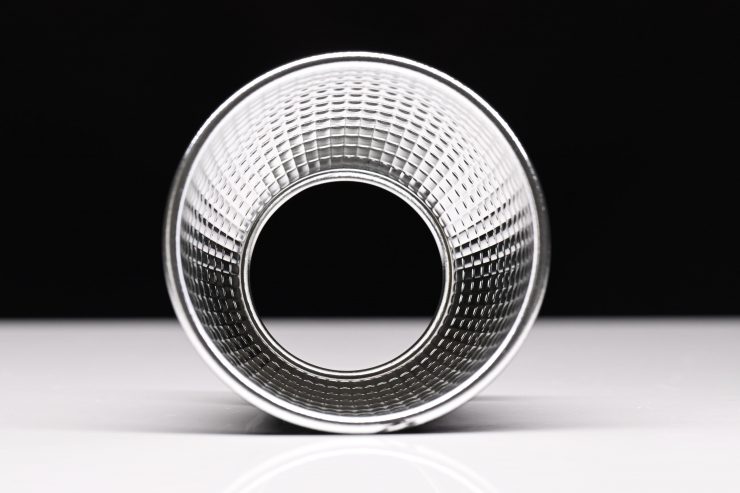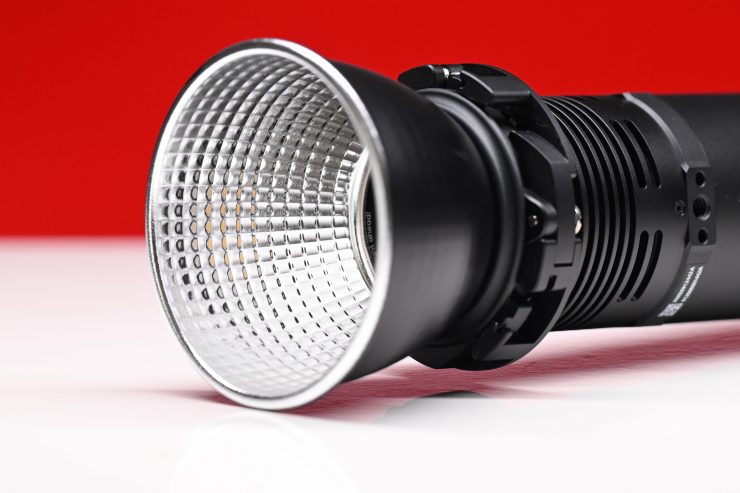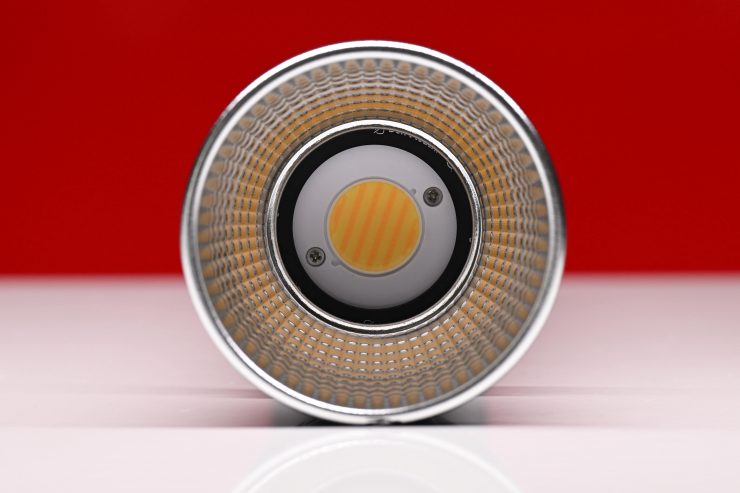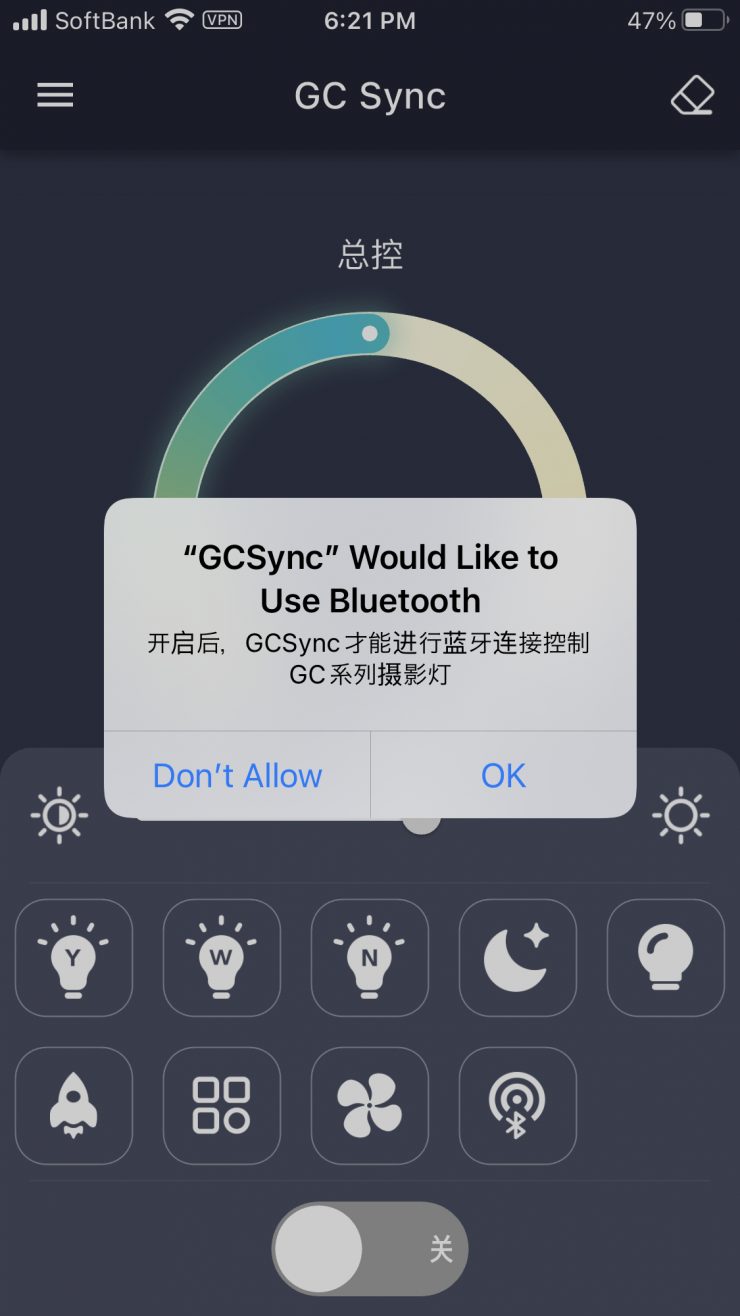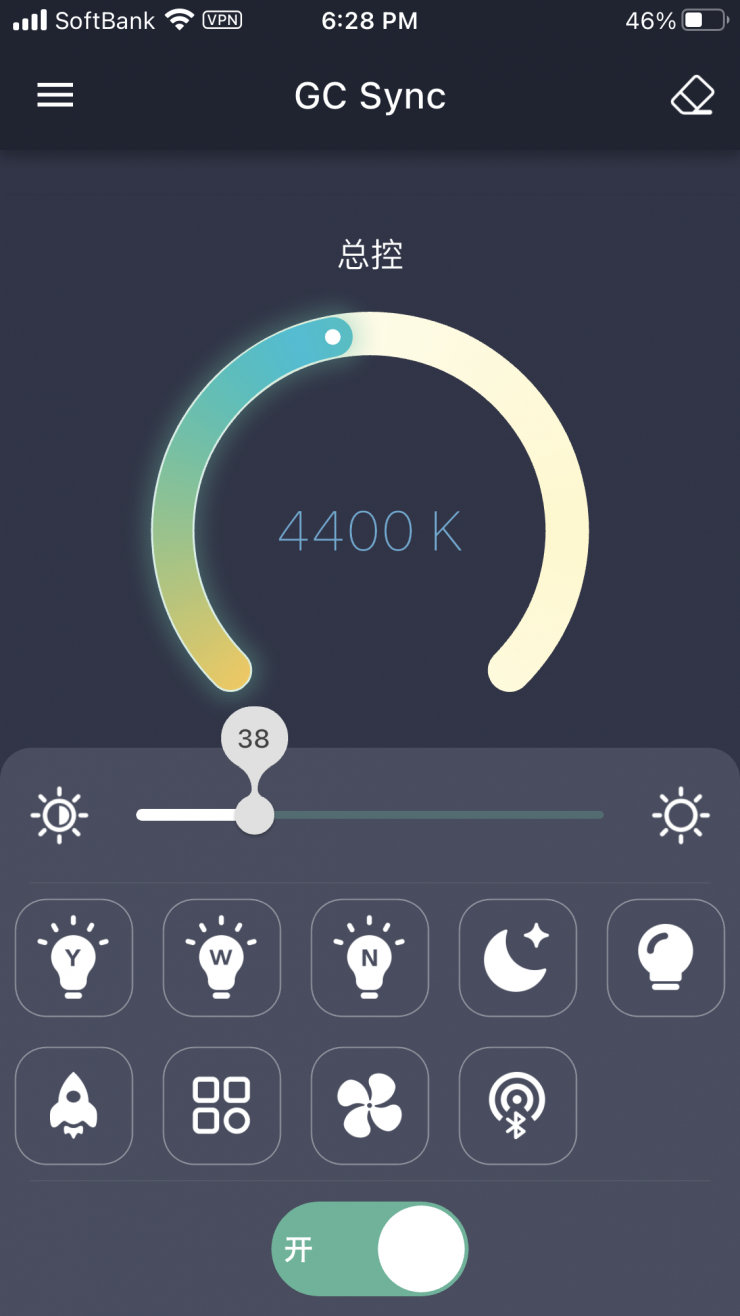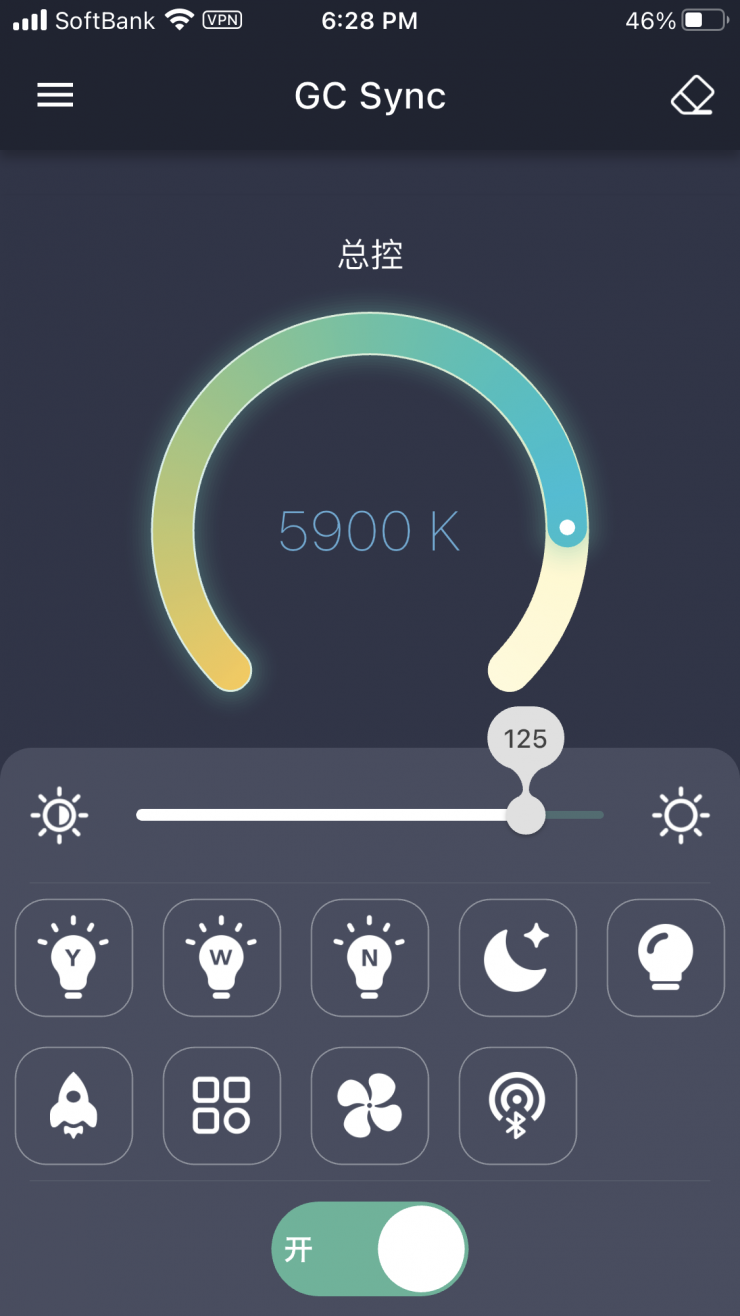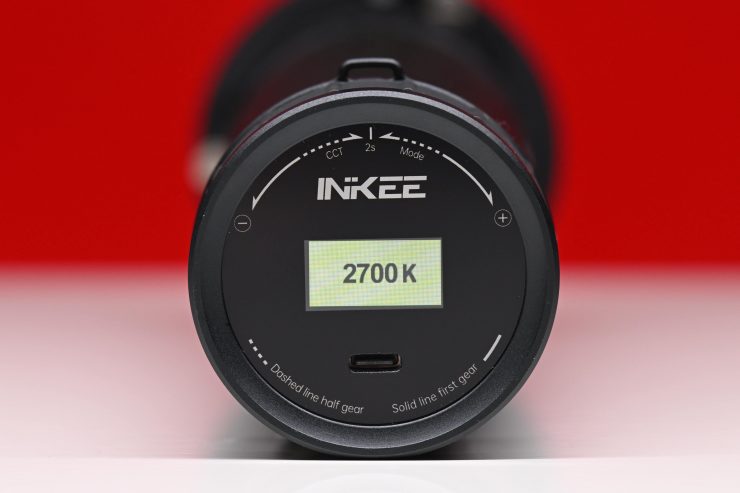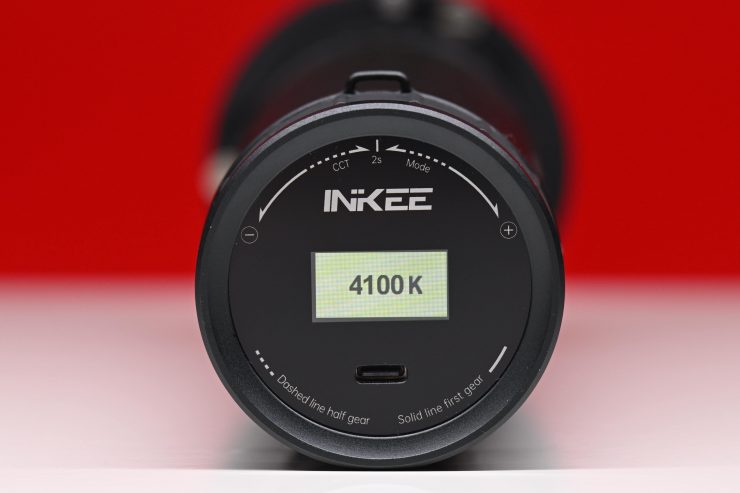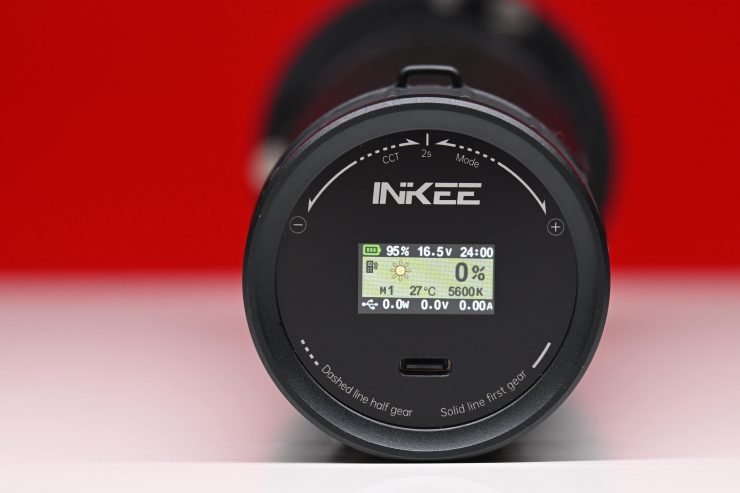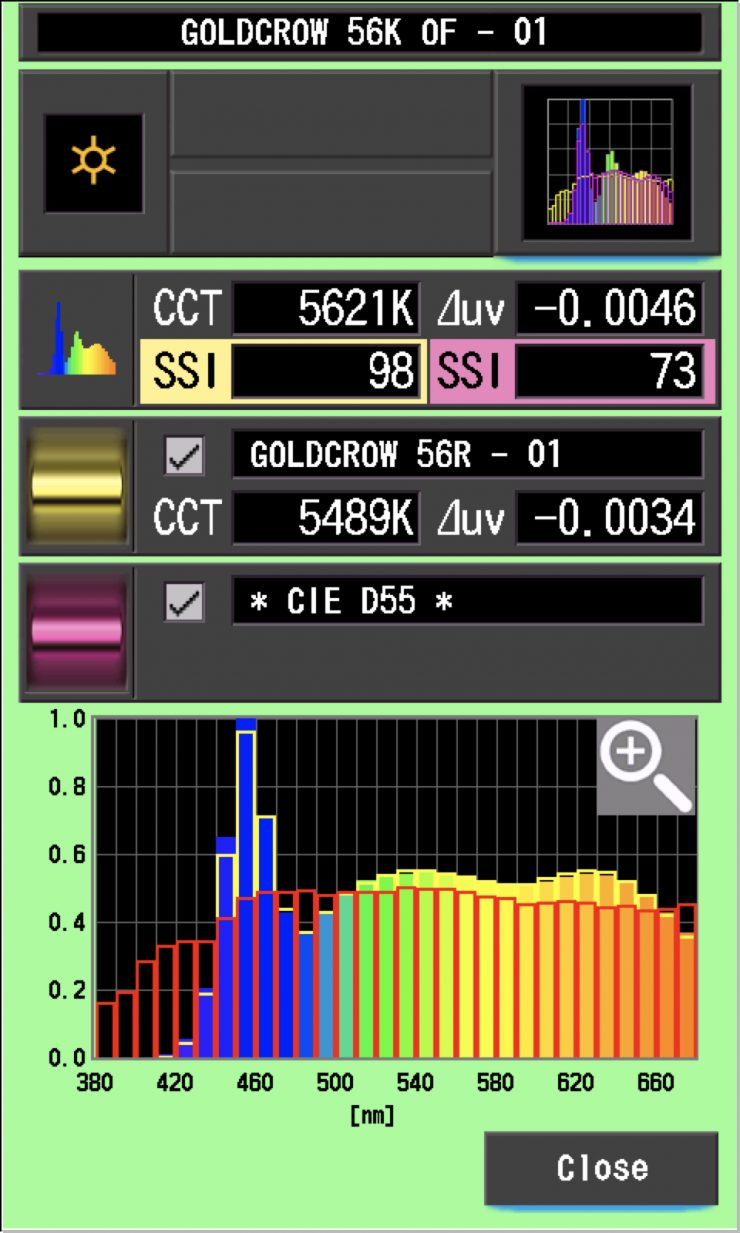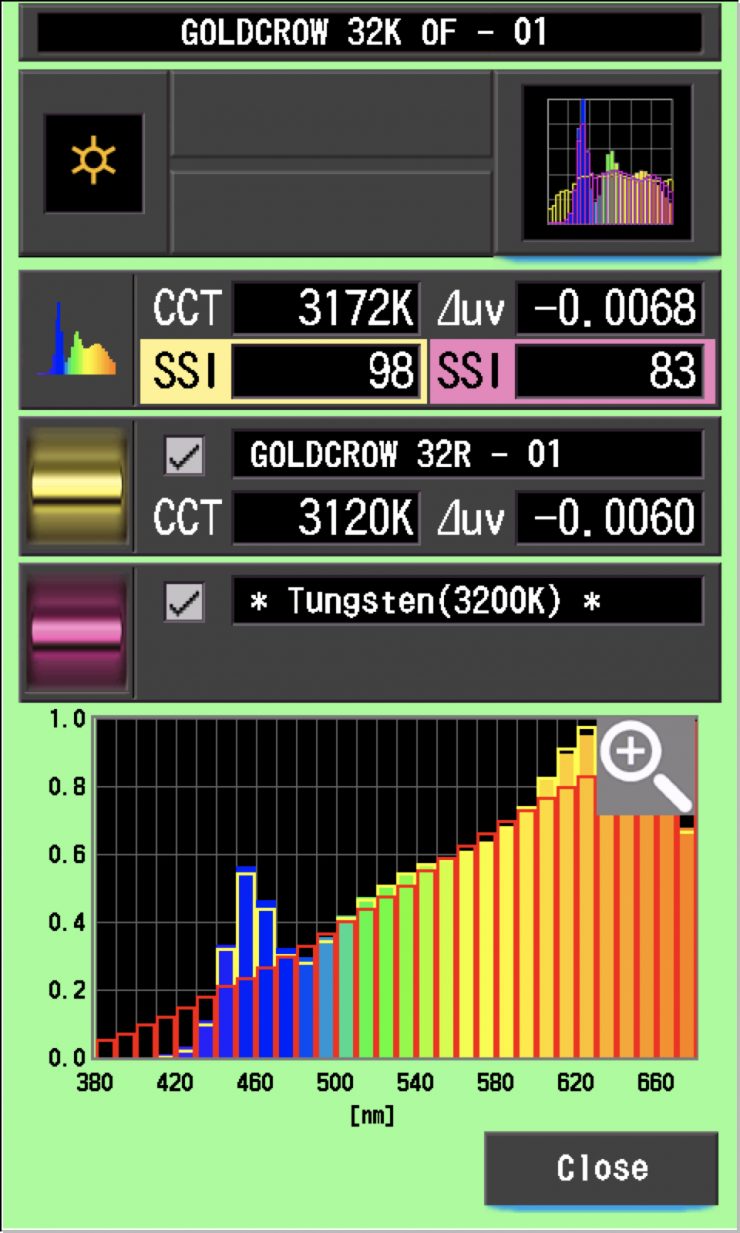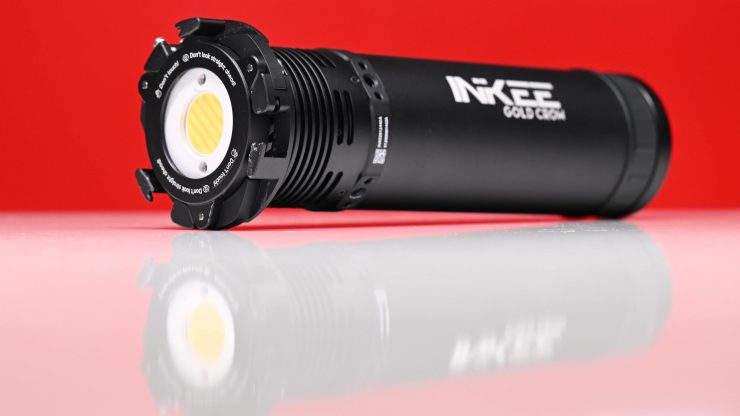
The INKEE Gold Crow 60W Bi-Color LED light has a rather unique name as well as featuring an unusual form factor so I was keen to look into it more closely.
The Gold Crow has a 60 watts output. and it features a built-in 142Wh 14.8V 9600mAh battery that will run the light for up to 2 hours at maximum brightness.
Concept
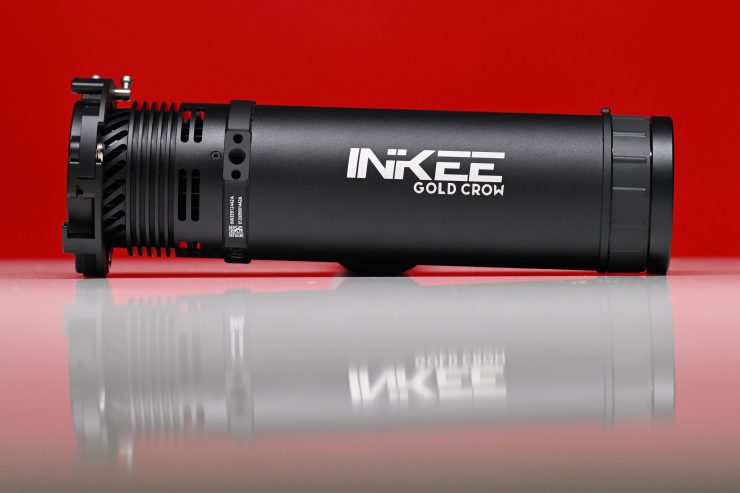
The concept behind the INKEE Gold Crow was to come up with an inexpensive, lightweight, lighting source with a built-in battery that could be used for a variety of different applications by content creators.
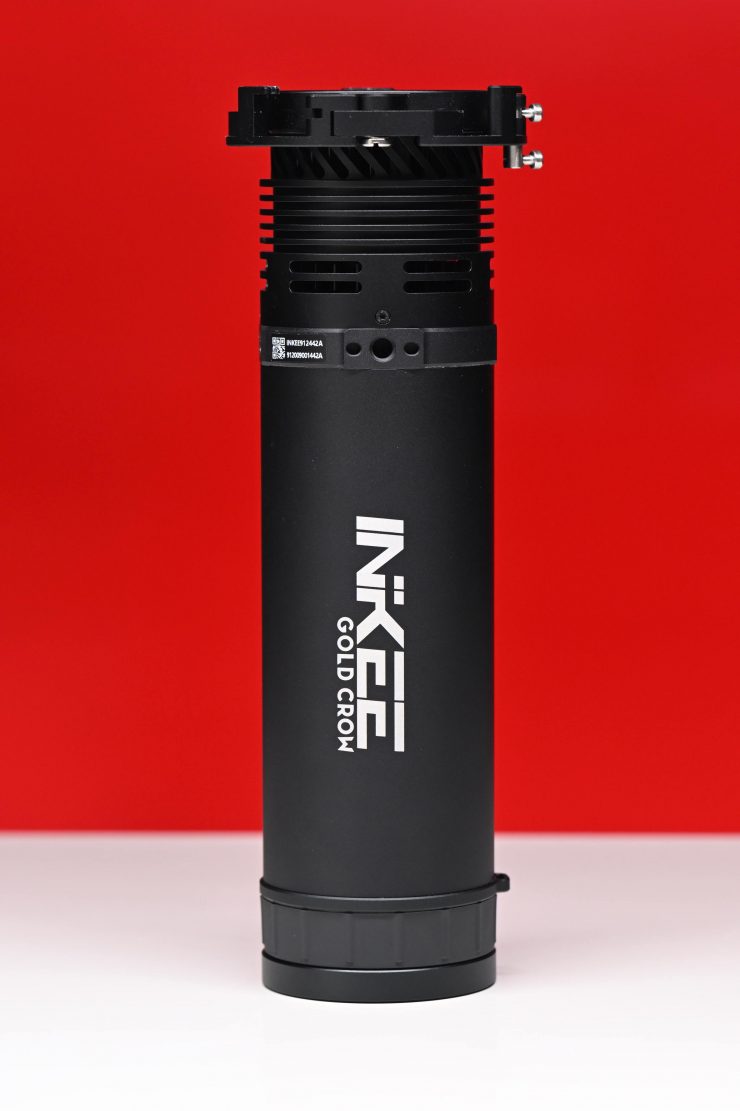
The INKEE Gold Crow looks quite different from a lot of other LED lights on the market. In some ways, it looks like an oversized flashlight.
Who is Inkee?
I had never heard of Ikee before. Inkee is a small Chinese company specializing in the design and development of film and television equipment. Up until now, they have mainly been making small-sized gimbals, tripods, accessories, etc.
Build Quality
The build quality of the INKEE Gold Crow actually surprised me in a good way. The casing of the light is made out of some type of hardened steel and it feels nice and robust.
The light was designed to work in inclement weather conditions. The housing is claimed to be waterproof, but it doesn’t list in what capacity. I imagine you could use this in the rain, but I don’t believe you could submerge it in water.
The only part of the Gold Crow that feels a bit flimsy to me is the large control ring on the back. It wobbles around and it is made out of plastic and not metal like the rest of the fixture. While it does work ok, I would have preferred to have seen this made out of steel and have a more tactile feel when using it.
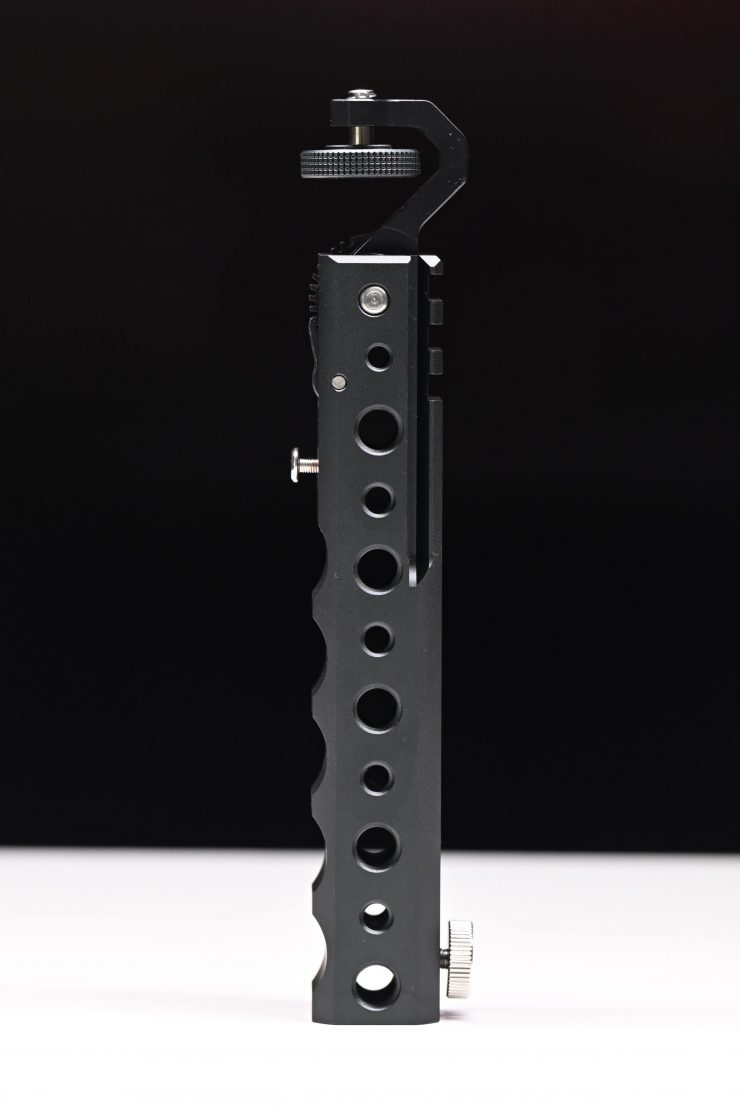
The included HD-1 handle/ light stand attachment is solidly made and well-constructed.
Weight & Size
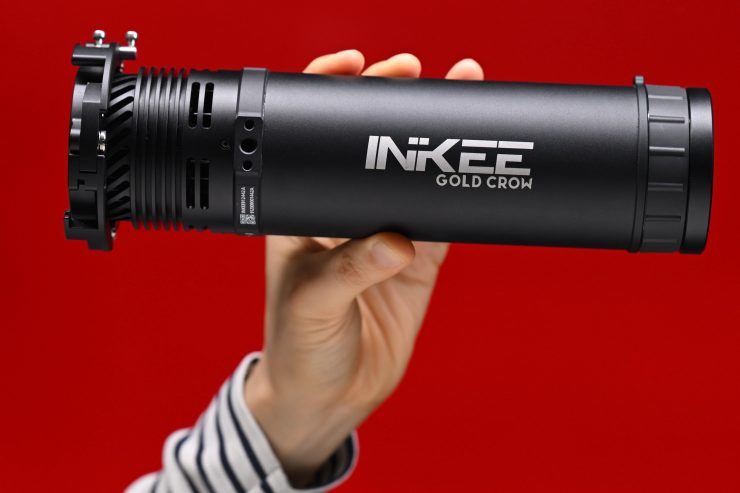
The INKEE Gold Crow weighs in at just 2.2 lb / 0.99kg. The diameter of the light is 2.36″ / 5.99cm, and the length is 9.17″ / 23.29cm without the reflector. This compact size and low weight make it a good option for anyone who is traveling. It would also be a handy back up light to keep in your kit.
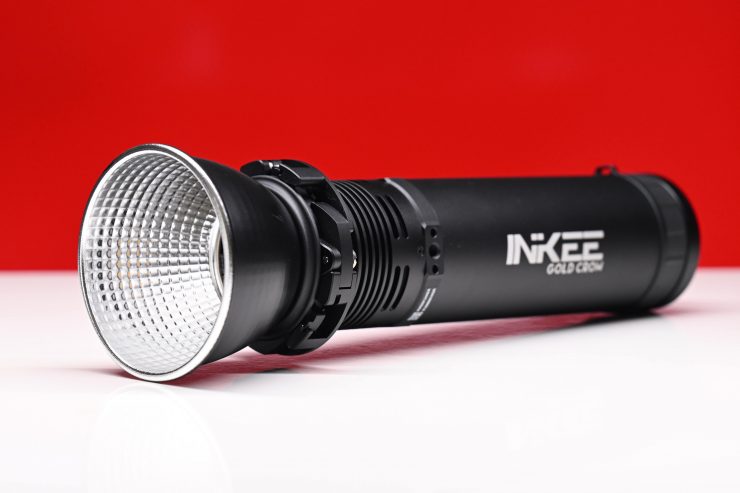
So how does this weight compare to some other lights that could be considered competition? Below you can see:
| TOTAL WEIGHT | |
| INKEE Gold Crow | 2.2 lb / 999g |
| Aputure LS 60x | 4 lb / 1.8 kg |
| amaran COB 60x | 5.72 lb / 2.59 kg |
| Nanlite FS-60B | 1.87 lb / 848 g |
| Zhiyun MOLUS G60 | 0.7 lb / 299 g |
| Sirui C60B | 1.5 lb / 700 g |
| Westcott L60-B | 1.5 lb / 700 g |
If you look at the weight comparison above, you can see that the INKEE Gold Crow isn’t that light, but you do have to remember that its in-built battery is probably responsible for a lot of that.
Mounting
The light has four 1/4-20″ mounting holes on it for attaching the included HD-1 handle/ light stand attachment.

There is a small silver screw that you push with your finger to adjust the angle of the light. This uses a type of ratchet system and it only allows for 90 degrees of rotation which is not ideal. If you have the light mounted so the front is facing away from the front side of the handle, you can’t point the light up, you can only point it down.
If you want to angle it down, you need to reverse the mounting, so most of the weight is now at the back of the center of gravity. It is slightly annoying having to take the light off the mount and put it back on in the opposite direction if you suddenly need to angle it up.
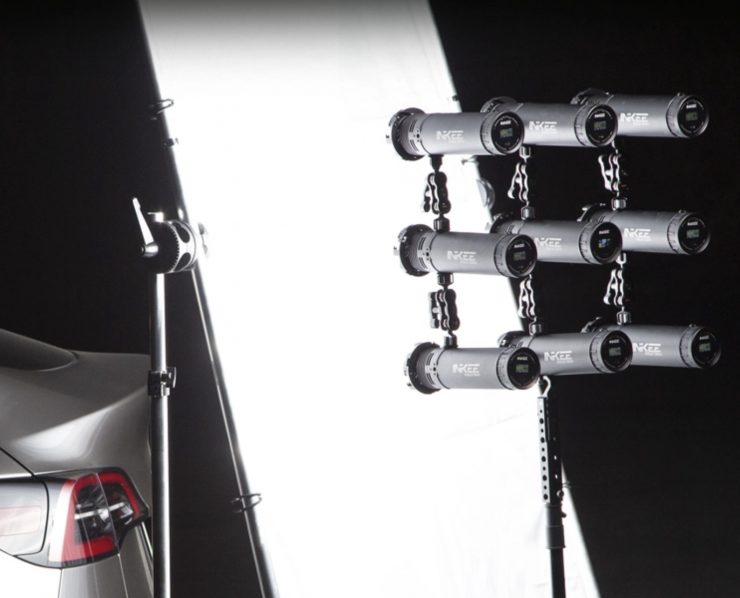
Because the light has multiple mounting holes you can attach multiple Gold Crow fixtures together to create a larger source. The only problem with this is that because there is no DMX, you would have to individually control all of the lights separately.
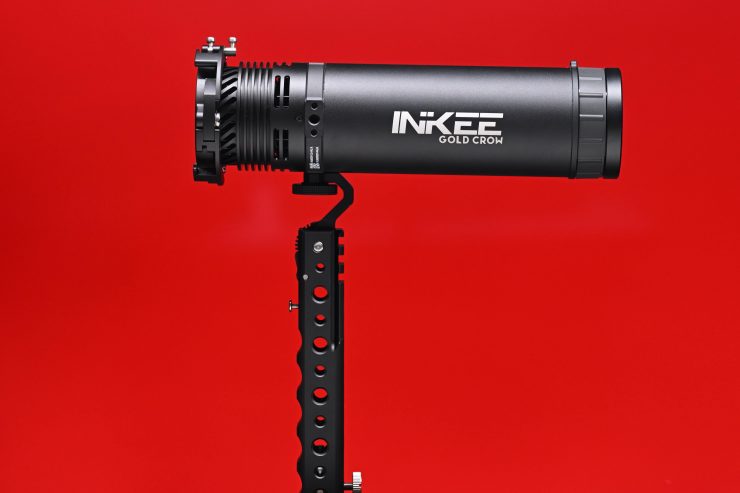
If you are attaching the HD-1 to a light stand then you need to undo this little metal thumb screw at the bottom. Now, while this does work as it should, I did find it a little hard to grip and turn. I am not sure why they didn’t just put on a normal locking mechanism as everyone else does.
INKEE also didn’t put two holes on the light stand adapter so you can’t mount the fixture in multiple ways.
Bowens Mount Adaptable
A nice aspect of the Gold Crow is that you can simply rotate three small arms from the light to be able to attach any lighting modifier with a Bowens Mount adapter. This is a little tricky to do and I would recommend attaching the light to the modifier instead of trying to attach the modifier to the light.
Being able to use Bowen Mount accessories is a nice feature, but because the light is so small, you do need to be careful how big those accessories are that you attach as all the weight is being supported by one tiny piece of metal. Two out of the three arms are essentially just holding the lighting modifier mount without being locked in.
If you tried to run any type of lighting modifier that was too big or heavy I would be very concerned about the arms snapping off the light.
Power Draw
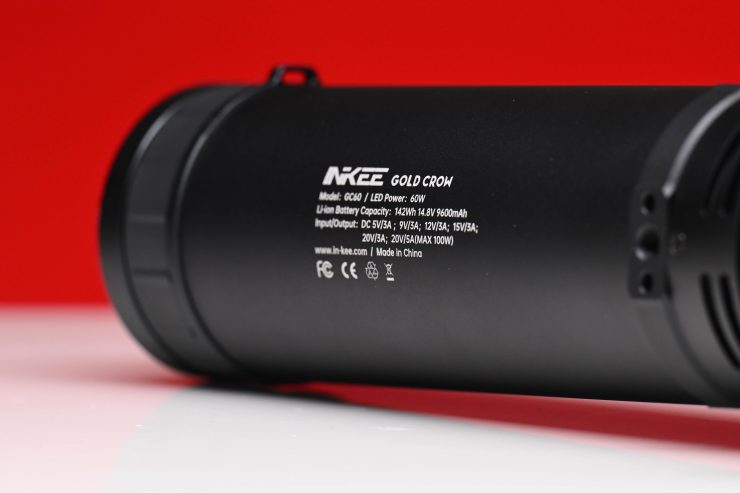
The INKEE Gold Crow draws a maximum of 90W, but the rated power of the lamp head is 60W.
| POWER DRAW | |
| INKEE Gold Crow | 90W |
| Aputure LS 60x | 90W |
| amaran COB 60x S | 78W |
| Nanlite FS-60B | 70W |
| Zhiyun MOLUS G60 | 60W |
| Sirui C60B | 60W |
| Westcott L60-B | 90W |
So how does this power draw compare to some other lights that could be considered competition? Above you can see.
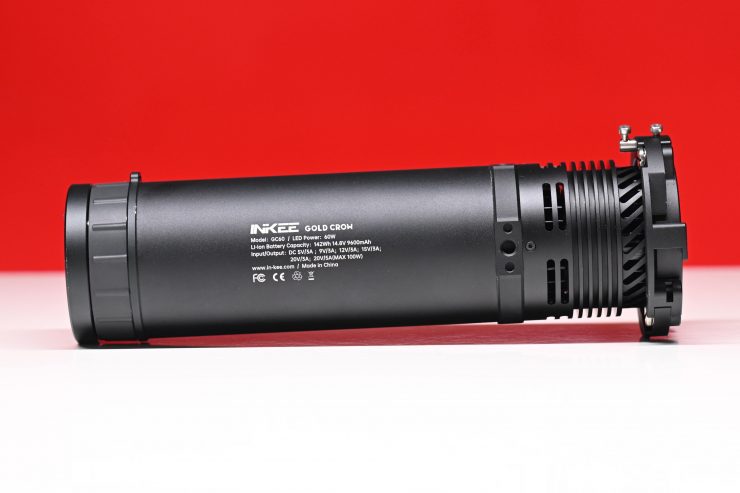
The Gold Crow, as I previously mentioned, features a built-in 142Wh 14.8V 9600mAh battery that will run the light for up to 2 hours at maximum brightness.
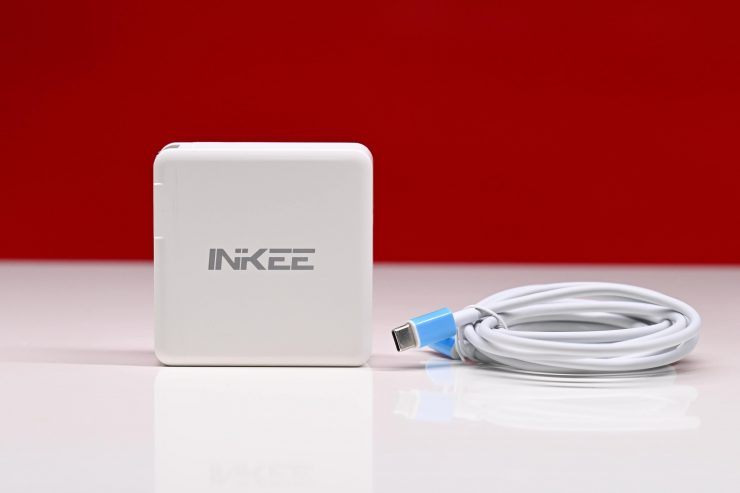
You can run the light directly via mains power but you can only do this by using the included USB-C wall charger. You can run it and charge it at the same time via a compatible USB-C source or from the included USB-C wall charger.
It takes around 2.5 hours to fully charge, however, it will get to around 80% charge in 1.5 hours.
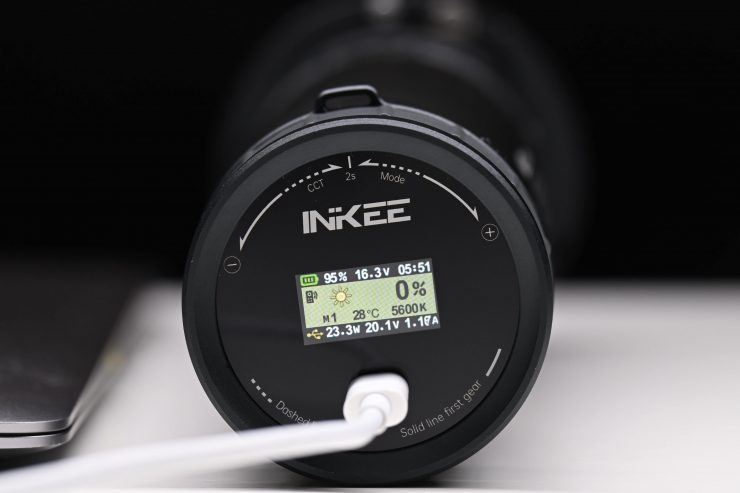
What is interesting is that you can use the in-built 142Wh 14.8V 9600mAh battery in the Gold Crow to power or charge other devices by attaching a USB-C cable. You can charge or power your laptop or other devices remotely on the road. This makes it a very useful emergency power supply.
The display on the light will tell you how much power is being drawn from the Gold Crow via USB-C.
How does it stay cool?
COB lights get very hot, and keeping them cool is not an easy task. Using fans is the best solution, but the caveat with fans is that they can create noise.
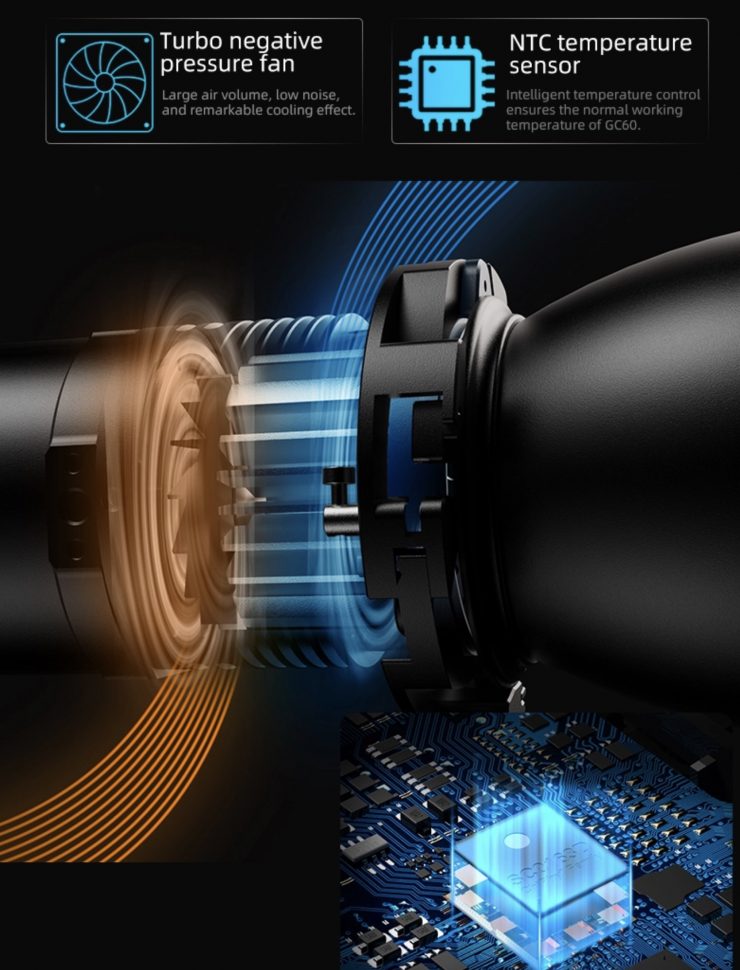
The Gold Crow does feature a large fan, but there are no controls to adjust the fan. The fan is very quiet even when operating at 100% output for long periods of time, however, the housing does get hot to touch.
Beam Angle
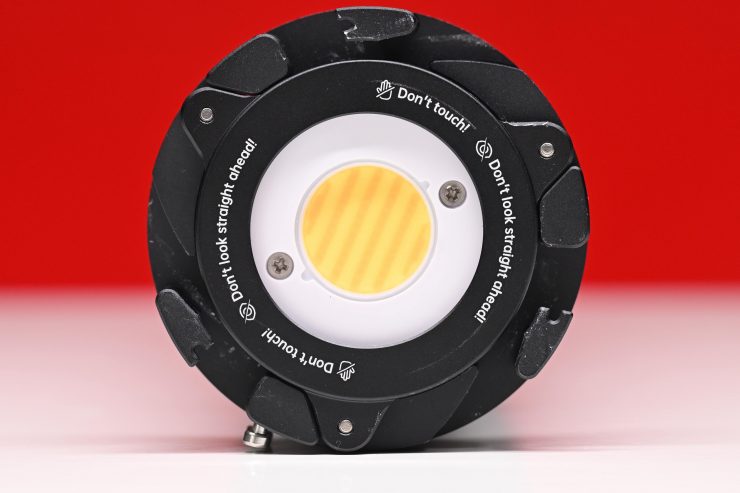
The native beam angle of the INKEE Gold Crow when used open face is 160°. This is very wide and handy for a lot of situations where you want to create a broad spread of light.
You can alter that beam angle by using the included reflector. INKEE does state what the beam angle of the reflector is, but I would estimate it to be somewhere between 100-120°.
Controls & Menu System
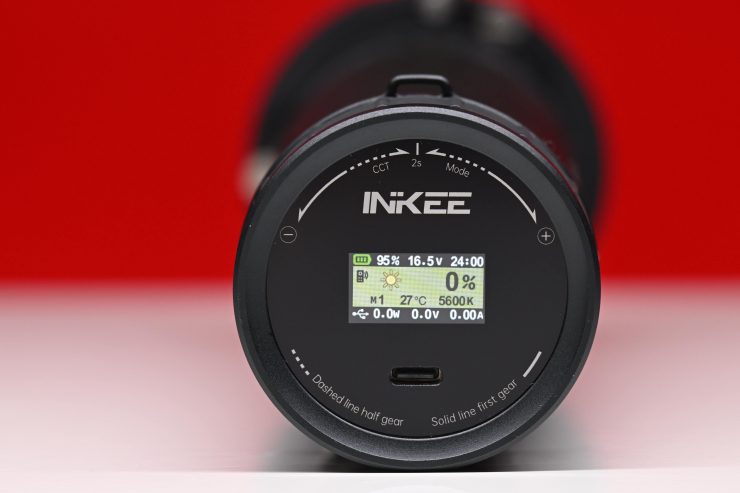
The INKEE Gold Crow has a clear and concise LCD screen that clearly shows you information about the light. While there is nothing overly fancy about it, it certainly does the job.
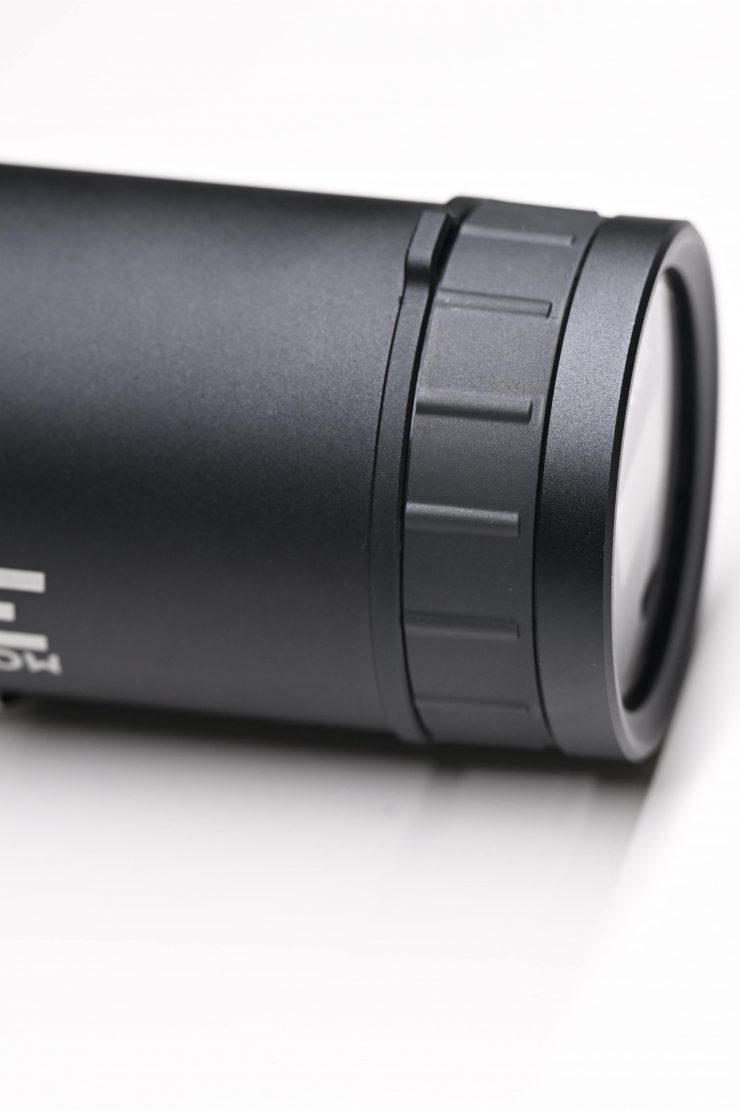
To make adjustments you need to turn the large control dial near the back of the light.
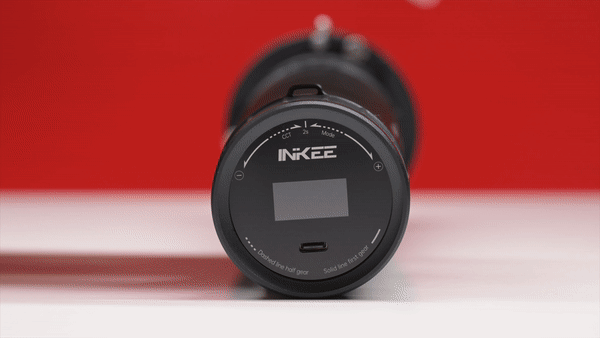
Now, you can put the light into a transport mode so that it won’t accidentally turn on (the light actually turns up in this mode). When you first turn the control ring you will see a symbol of a plane next to a padlock. What you need to do is to keep turning the control ring clockwise continually. At the bottom of the display screen, you will see an orange bar that keeps getting longer. You need to keep turning the control ring until the light eventually unlocks.

Once it is unlocked from flight mode, it is still in another lock mode. To turn the light on you need to again, keep turning the control ring quickly until it eventually unlocks. Every time the light goes into its screen sleep mode (this happens after about 5 seconds if nothing is touched) you need to unlock it again. I wish there was an option available so you didn’t have to do this.
Once it is unlocked, you simply turn the control dial to adjust the brightness.
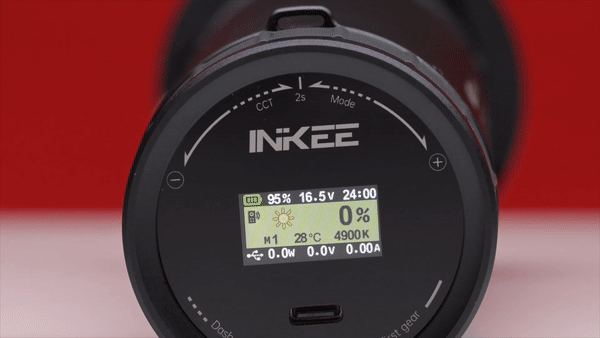
Making other adjustments can be quite confusing. To change the CCT you need to turn the control ring slowly to the right and hold it for 2 seconds to access the CCT menu. You then release the control ring and make your adjustment.
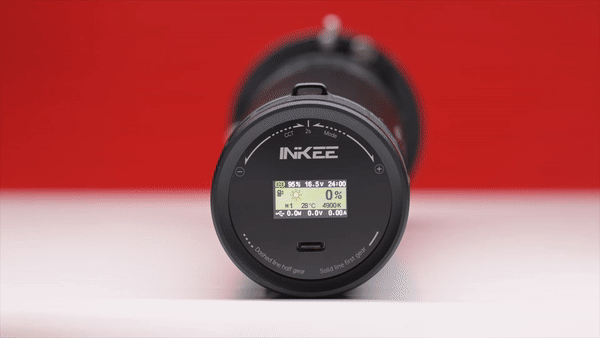
To access the effect modes, you need to turn the control ring slowly to the left and hold it for 2 seconds. Again, you then release the control ring and turn it to select whatever effect you want.
With a good light, you shouldn’t have to read a manual to work out how to operate it. You should be able to turn it on and use it straight away. While the Gold Crow is easy enough to use, it is complicated to first turn on without having to consult the operating manual. The problem I have is that if you give the light to someone else to control or use and they aren’t familiar with it they won’t be able to work out how to turn it on or make adjustments.
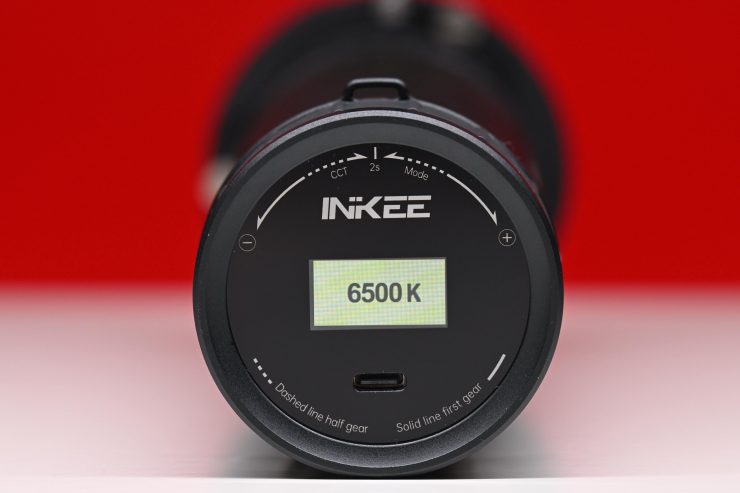
The control ring that you use to control the light isn’t very tactile and I found that operating the light was unnecessarily confusing.
I would have preferred to have seen a couple of small buttons or dials on the light for selecting CCT and effects.
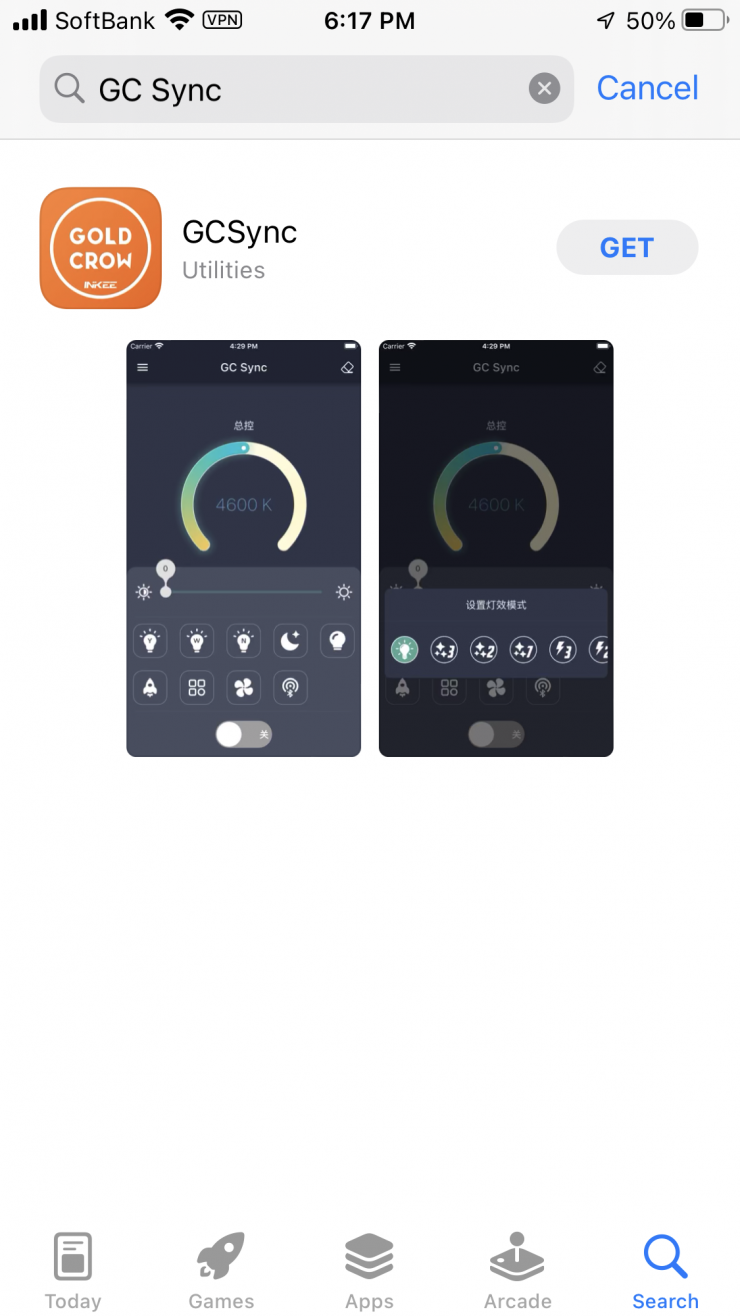
There is an app available for controlling the light called GCSync. Currently, this is only available for iPhone, but an Android version is coming in August.
The app works reasonably well, but because it uses Bluetooth there is a bit of lag from when you make changes on the app until you see them being reflected on the light.
The App, just like the remote controller that I will talk about in a minute, is a little tricky and not very intuitive to connect. You really need to watch the above tutorial video to work out how to do it.
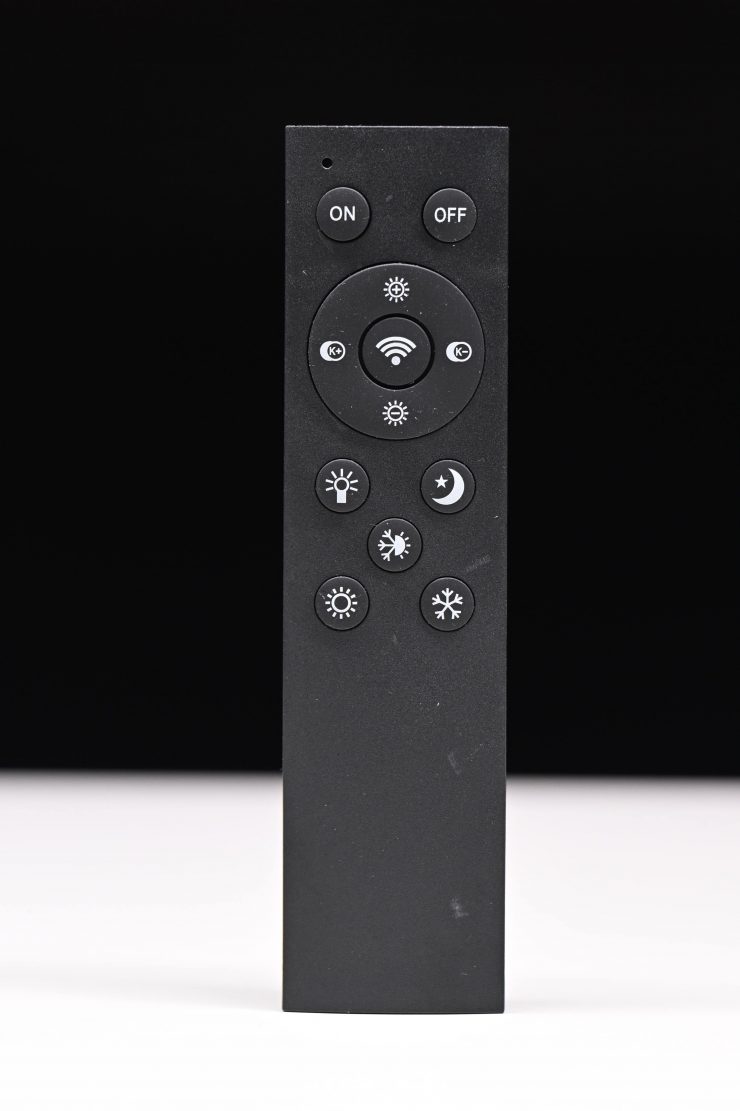
INKEE does have a remote controller available that comes with the light (but only during the promotional period.) After the promotional period, it will be an optional extra. The trouble is the only instructions for using it are on the back of the box it comes with and there is nothing listed in the included manual.
The remote controller is a bit overly complicated to pair, but once you have done it it works well. I personally found the light way easier to control using the remote than using the onboard controls.
Operating Modes
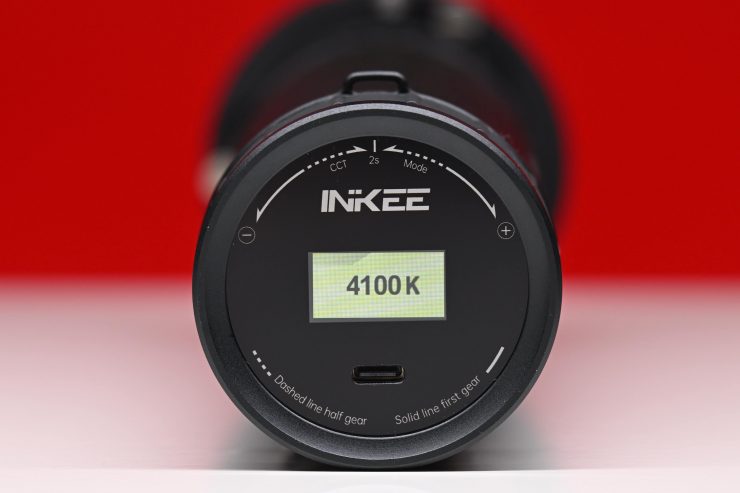
The light has just two lighting modes:
- CCT
- Effects
Correlated Color Temperature (CCT)
In the CCT Mode, you have full access to making CCT adjustments between 2700-5600K. This isn’t a massive adjustment range.
The fixture doesn’t feature any continuous variable (full minus green to full plus green) correction.
Effects
The light allows you to use 5 different effects:
- Bad TV
- Bad Bulb
- Flashing
- Lightning
- SOS
When using the effects you can adjust the CCT value, however, you can’t adjust any of the parameters.
Photometrics
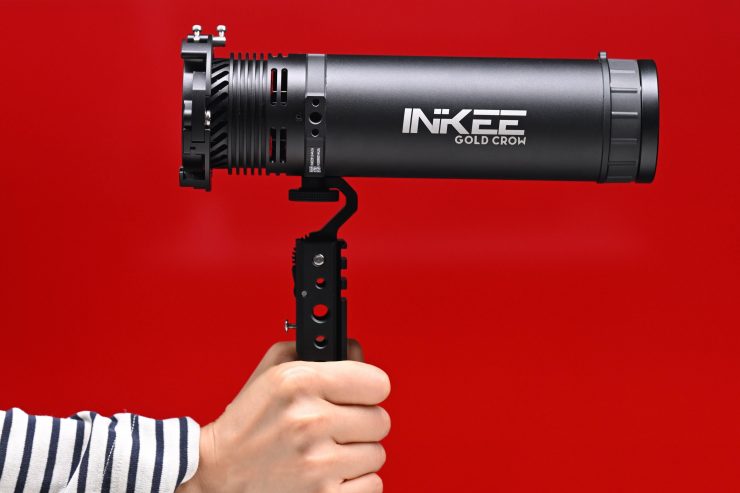
So now let’s get to the photometric results. I always test lights in this way so that I get a reference to how they compare to other fixtures. Results only tell part of the story and should never be used alone to judge a light. I have found from extensive testing over the years that certain lights that have good photometric results don’t always look good, and lights that have worse photometric scores can sometimes look better than their results indicate.
You can’t judge a light from one set of photometric results. You have to look at all of the different results to be able to come to a conclusion. Judging alight on one set of results is like reading one chapter in a book and thinking you know the whole story.
Different lights can also look different depending on what camera you happen to be using.
Output & Color Temperature Accuracy
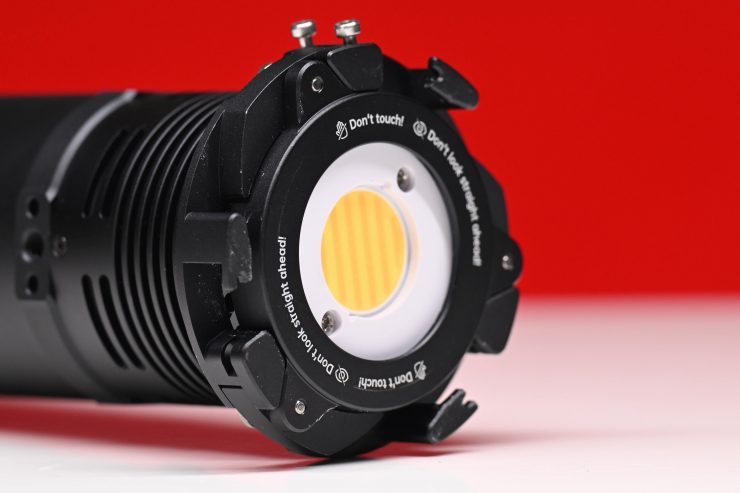
I tested the INKEE Gold Crow at a variety of CCT settings with a Sekonic C-800 Spectrometer to find out how much output the light had and how accurate the CCT reproduction was. All readings are taken at a distance of 1m (3.28ft) in a controlled environment. The readings were all taken directly from the lighting source. In the case of using the light with a Reflector or any attachment, the readings were taken from the edge of those attachments. This is how I test all lights.
So just how much output does it have? Well, let’s find out.
INKEE Gold Crow 5600K (open face)
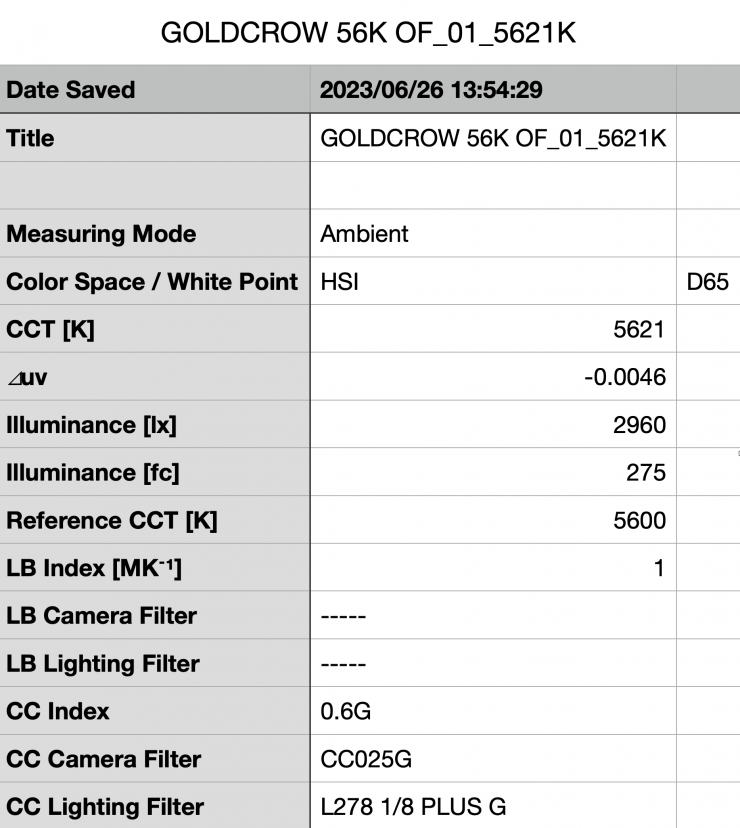
Above you can see the Inkee Gold Crow recorded an output of 2960 lx (275 fc) when set at 5600K and used open face. This was a decent amount of output for a light of this size with a beam angle of 160 degrees.
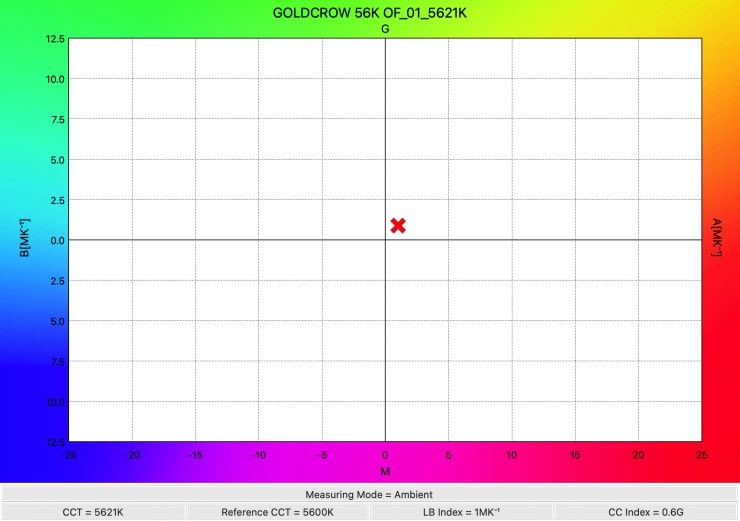
The light recorded a CCT reading of 5621K which was an excellent result.
INKEE Gold Crow 3200K (open face)
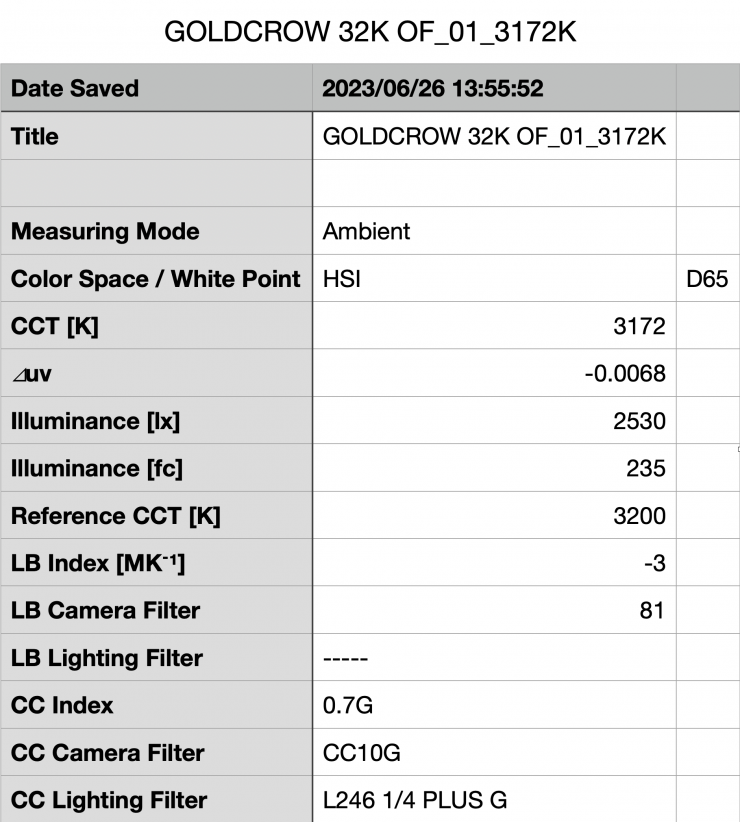
Above you can see the light’s output when it was set at 3200K in the open face configuration was 2530 lx (235 fc), which was 14.5% less than it produced at 5600K.
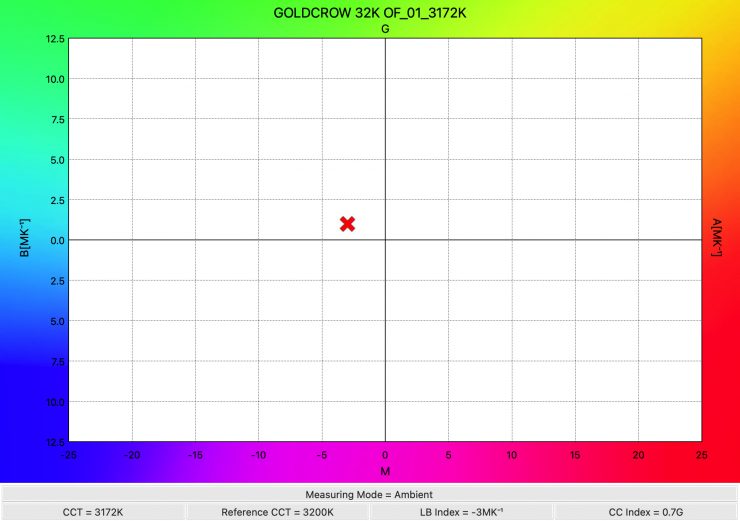
As far as CCT accuracy goes, it recorded a very good reading of 3172K.
INKEE Gold Crow 5600K Reflector
Now, that we have seen some results when it was used open face, what happens if we use it with the included reflector?
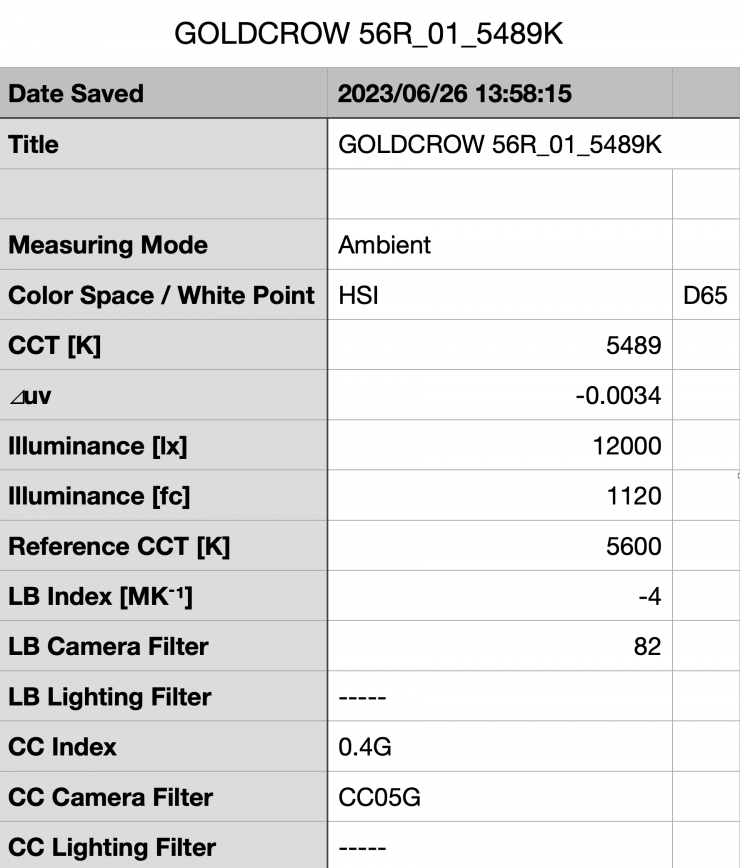
Above you can see the light’s output when it was set at 5600K with its reflector was 12,000 lx (1120 fc), which was 305% more than it produced when used open face.
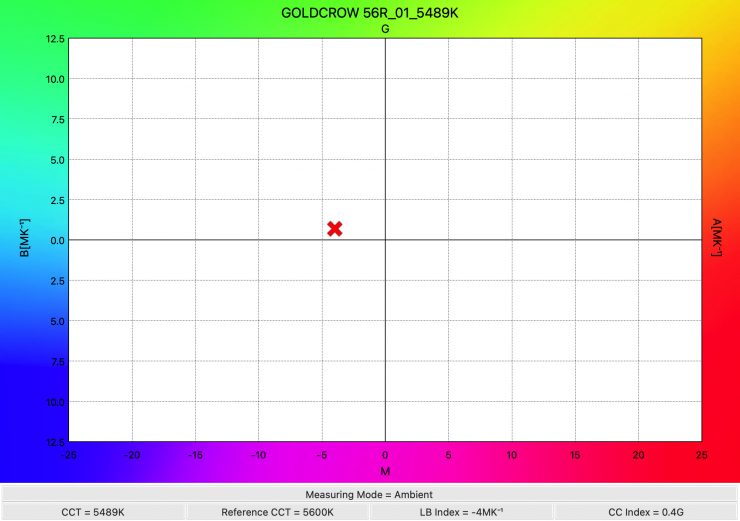
As far as CCT accuracy goes, it recorded a reading of 5489K, which wasn’t nearly as good as the 5621K it recorded when used open face. This clearly tells me that the reflector alters the CCT.
INKEE Gold Crow 3200K Reflector
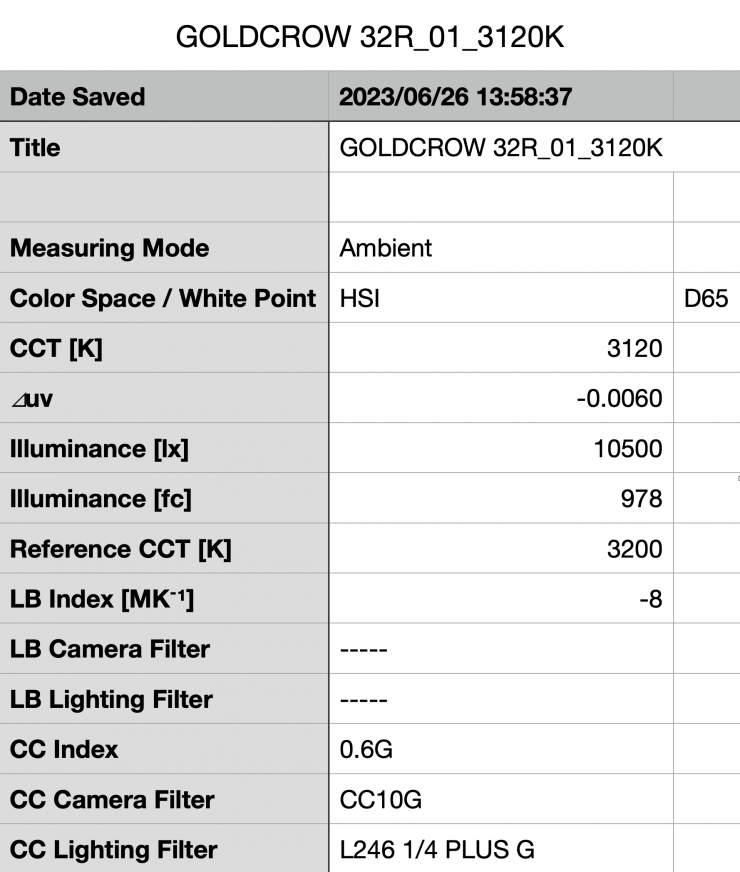
Above you can see the light’s output when it was set at 3200K using its reflector was 10,500 lx (978 fc), which was 14.2% less than it produced at 5600K.
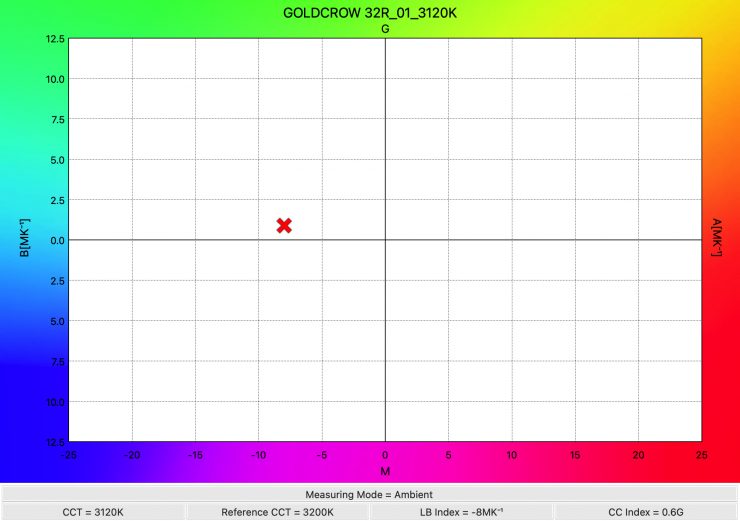
As far as CCT accuracy goes, it recorded a reading of 3120K which wasn’t too far off the 3172K it produced when used open face.
This tells me that the reflector doesn’t alter the CCT too much when used at 3200K.
How does it perform at various CCT Settings?
Summary of results (Open Face)
| SETTING | OUTPUT | CCT READING |
| 2700K | 2400 lx | 2656K |
| 3200K | 2530 lx | 3172K |
| 4500K | 2740 lx | 4532K |
| 5600K | 2960 lx | 5621K |
| 6500K | 2900 lx | 6575K |
These results show me that the light’s output varies by 23.3% depending on what CCT temperature you are using between 2700-6500K.
The CCT accuracy across the range is very good. It was no more than 75K off at any reading which tells me the light has very good CCT consistency across its range.
CCT consistency & linear output when dimming the light
Now, what you should always do when testing lights is to see if the CCT remains consistent when dimming the light. Just because you set a light at say 5600K, that doesn’t mean that the CCT will remain stable as you start dimming the fixture down. I also wanted to see how linear the dimming curve was.
I decided to do a series of tests at 100%/75%/50%/25%10% to see if the CCT being recorded changed. This was done at a distance of 1m using a Sekonic C-800. These tests were done at 5600K Open Face.
| CCT READING | OUTPUT | INTENSITY % |
| 5621K | 2960 lx | 100 |
| 5679K | 2180 lx | 75 |
| 5678K | 1550 lx | 50 |
| 5654K | 862 lx | 25 |
| 5596K | 422 lx | 10 |
The INKEE Gold Crow maintained pretty good CCT consistency as you start dimming the fixture. My testing showed that the CCT readings varied by 83K.
As far as how linear the output is when you start dimming the light, at 50% output it had 47.6% less output than when used at 100%. At 25% it had 70.87% less output than when used at 100%. At 10% output, it had 85.7% less output than when used at 100%. This shows me that the light’s dimming curve is reasonably linear, but it could be better.
Color Rendering
So now that we have seen how much output the INKEE Gold Crow produces, how does it perform when it comes to replicating accurate colors?
INKEE Gold Crow 5600K (Open Face)
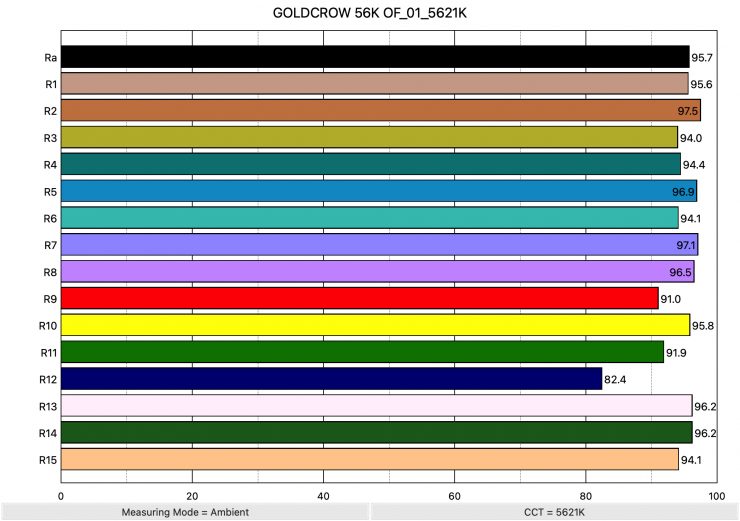
Above you can see that when the light was set at 5600K in the Ultra White mode recorded an average CRI (R1-R8) of 95.7 and an extended CRI (R1-R15) of 94.24. For replicating accurate skin tones it recorded for R9 91.0 (red), 96.2 for R13 (closest to caucasian skin tones), and 94.1 for R15 (closest to Asian skin tones). These were decent results, and only R12 (Blue), were all under 90.
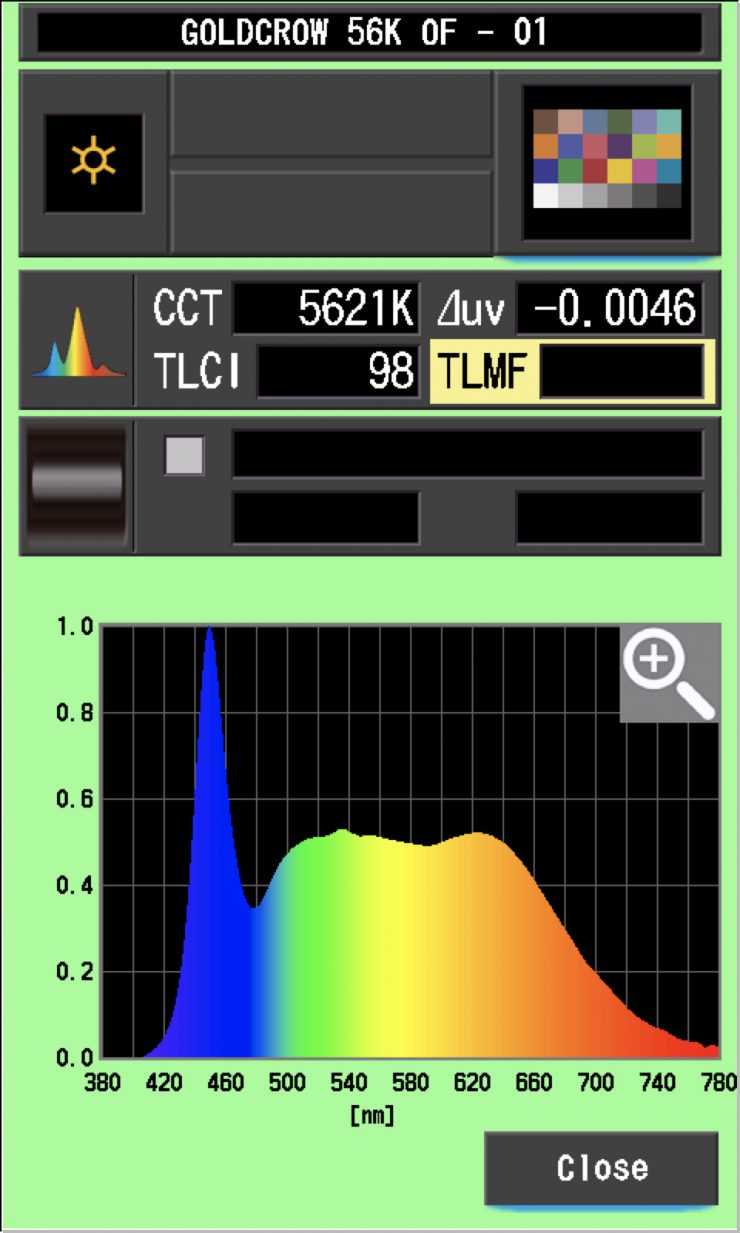
The INKEE Gold Crow, when set at 5600K, recorded a TLCI score of 98. This was a good result.
INKEE Gold Crow 3200K (Open Face)
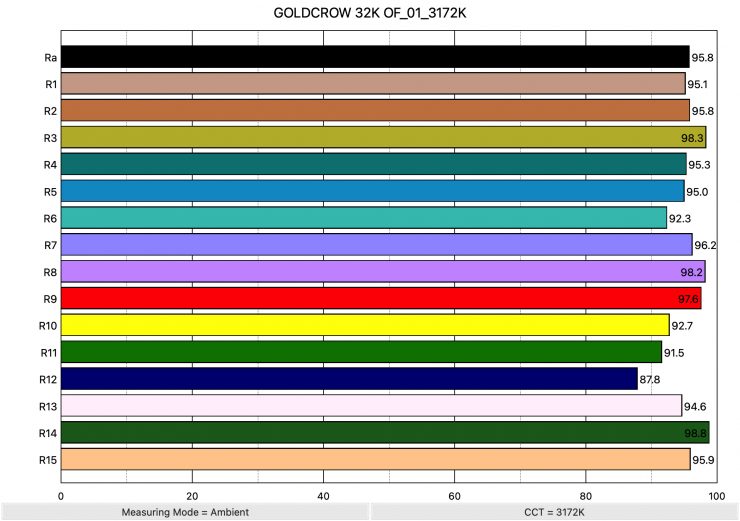
Above you can see the scores for when the light was used at 3200K. It recorded an average CRI (R1-R8) of 95.8 and an extended CRI (R1-R15) of 95.0. For replicating accurate skin tones it recorded 97.6 for R9 (red), 94.6 for R13 (closest to caucasian skin tones), and 95.9 for R15 (closest to Asian skin tones). These were good results. Only R12 was below 90, but not by much. The score for R9 (red) was very good for a modern day LED light.
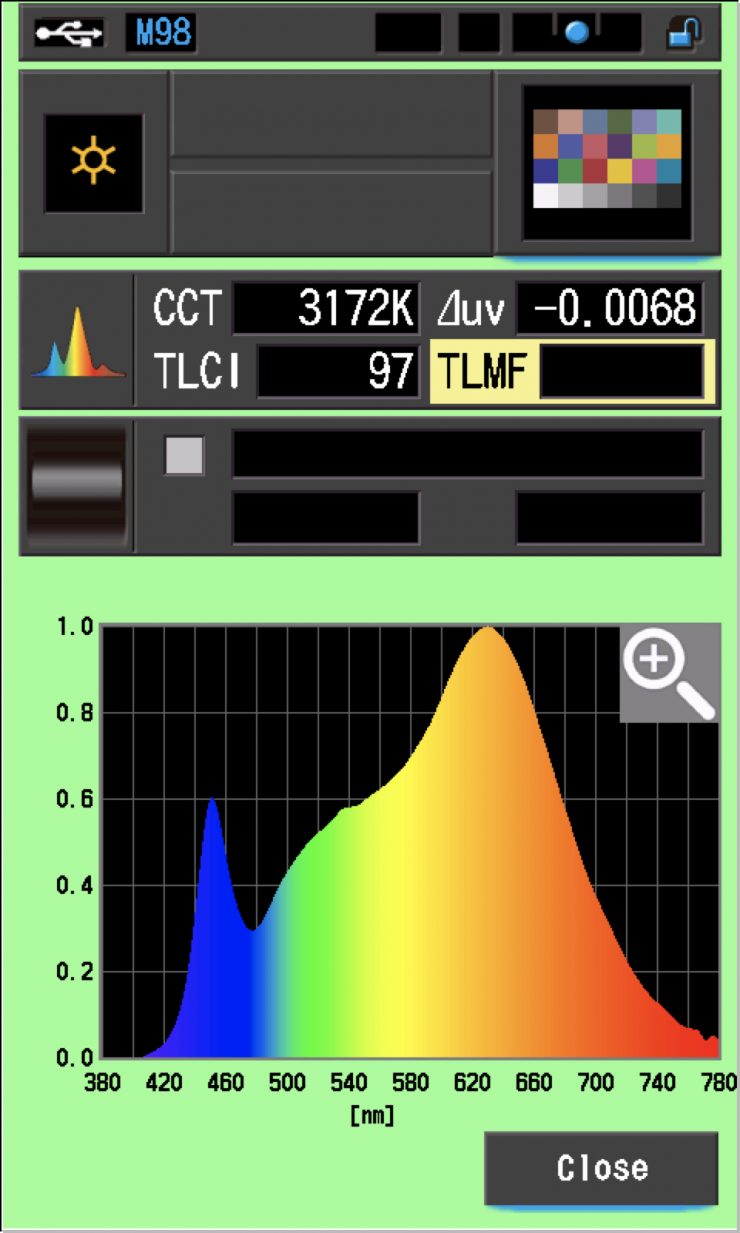
The INKEE Gold Crow, when set at 3200K, recorded a TLCI score of 97.
INKEE Gold Crow 5600K Reflector
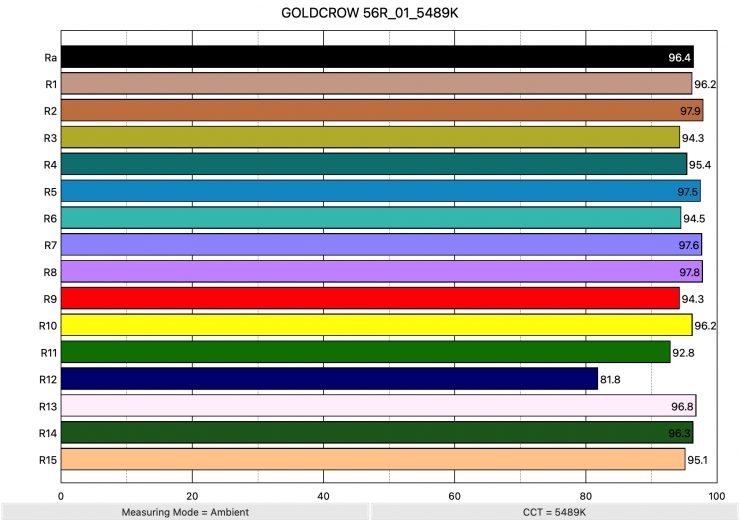
Above you can see that when the light was set at 5600K in the CCT mode recorded an average CRI (R1-R8) of 96.4 and an extended CRI (R1-R15) of 94.96. For replicating accurate skin tones it recorded for R9 94.3 (red), 96.8 for R13 (closest to caucasian skin tones), and 95.1 for R15 (closest to Asian skin tones). These are good results, and only R12 (Blue), was under 90.
What was interesting is that the scores were actually slightly better than when the light was used open face. In saying that, the light had very good color rendering consistency regardless of whether you were using it with or without the reflector.
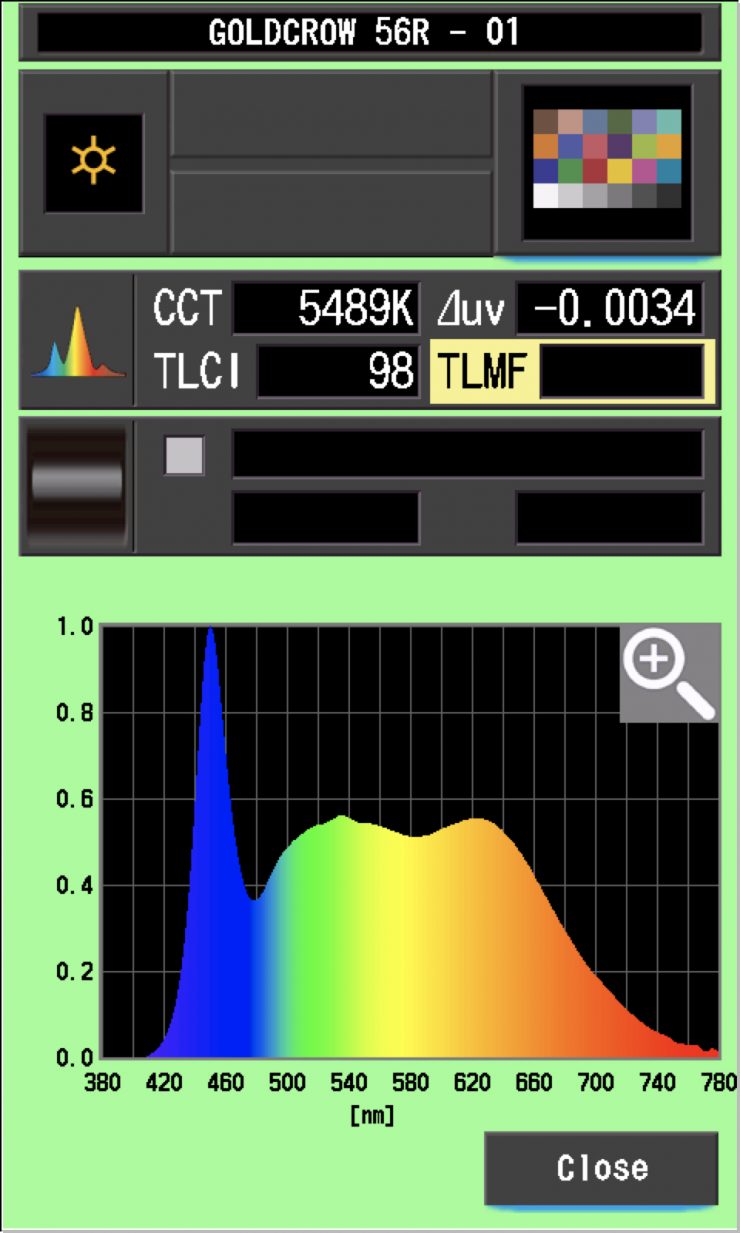
The INKEE Gold Crow, when set at 5600K and used with its reflector recorded a TLCI score of 98, which was identical to the score it had when used open face.
INKEE Gold Crow 3200K Reflector
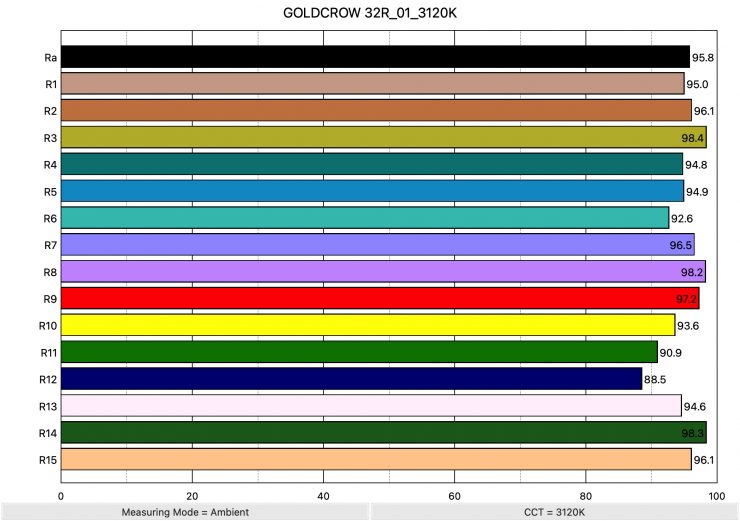
Above you can see that when the light was set at 5600K in the CCT mode recorded an average CRI (R1-R8) of 95.8 and an extended CRI (R1-R15) of 95.04. For replicating accurate skin tones it recorded for R9 97.2 (red), 94.6 for R13 (closest to caucasian skin tones), and 96.1 for R15 (closest to Asian skin tones). These were good results, with only R12 (Blue) being slightly below 90.
Again, the results were very consistent when using the light with or without its reflector.
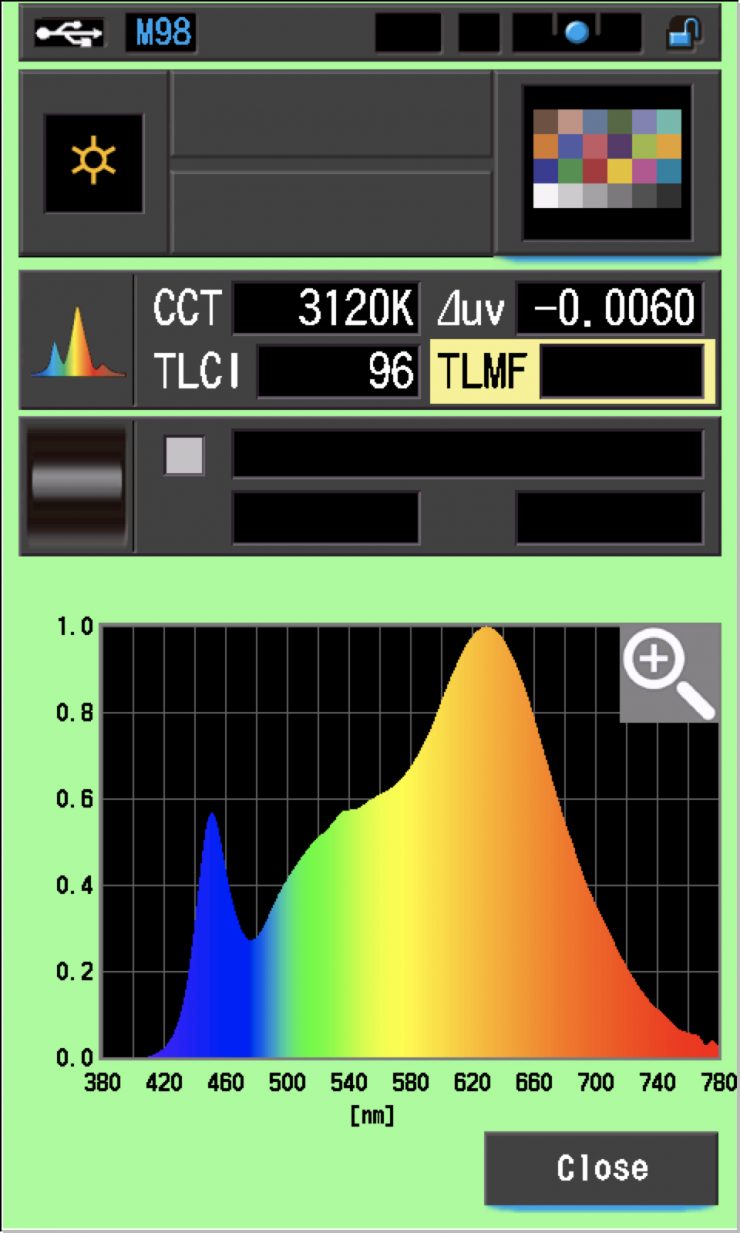
The INKEE Gold Crow, when set at 3200K and used with its reflector recorded a TLCI score of 96, which was just below the 97 it recorded when used open face.
CC Index & ⊿uv
The CC Index displays the CC correction value and whether any magenta or green need to be added or subtracted. 1 CC corresponds to 035 Kodak CC values or 1/8 Rosco filter values. Any reading less than +1.00 or -1.00 and you’re probably not going to need to make any kind of adjustment. The ⊿uv is the value to show how much this light is away from being an ideal light source (black body radiation = incandescent lamp). As with the CC Index you want this number to theoretically be zero. Kelvin is not a linear value, so we need to convert from Kelvin to MK-1 to compare the values of color temperature. To calculate from Kelvin to Mired is MK-1= 1*1000000/Kelvin. While this may sound confusing, it is the only way of measuring if the Kelvin shift is significant enough to warrant having to use a filter for correction. Below are the results for the INKEE Gold Crow:
INKEE Gold Crow Kelvin Vs MK-1
| Kelvin | Difference in K | MK-1 | Difference in MK-1 | |
| SET VALUE | 2700K | 0 | 370.37 | 0 |
| ACTUAL READING | 2596K | 104 | 376.50 | -6.13 MK-1 |
| SET VALUE | 3200K | 0 | 312.5 | 0 |
| ACTUAL READING | 3172K | 28 | 315.25 | -2.75 MK-1 |
| SET VALUE | 4500K | 0 | 222.22 | 0 |
| ACTUAL READING | 4532K | 32 | 220.65 | 1.57 MK-1 |
| SET VALUE | 5600K | 0 | 178.57 | 0 |
| ACTUAL READING | 5621K | 21 | 177.90 | 0.67 MK-1 |
| SET VALUE | 6500K | 0 | 158.84 | 0 |
| ACTUAL READING | 6575K | 75 | 152.09 | 6.75 |
These figures might look confusing, but what it tells me is that the light is very CCT accurate at 3200-5600K. Any MK-1 score that is under -9/9 means you wouldn’t have to use any color correction gels. The MK-1 scores for this light were excellent at 3200K to 5600K. Even at 270K and 6500K it was still pretty good. Any MK-1 score that is under -6/6 is a very good result.
Ok, now let’s look at the CC INDEX & ⊿uv.
INKLEE Gold Crow CC INDEX & ⊿uv
| CC INDEX | ⊿uv | |
| 2700K | 0.2G | -0.0014 |
| 3200K | 0.7G | -0.0068 |
| 4500K | 0.8G | -0.0084 |
| 5600K | 0.7G | -0.0055 |
| 6500K | 0.6G | -0.0033 |
These weren’t great results, but they weren’t terrible either. The light certainly does lean magenta, and from 3200K to 6500K the amount is a lot higher than at 2700K.
TM-30
TM-30 is a relatively new color rendering standard that was developed to deal with the limitations of CRI. TM-30 looks at 99 individual colors. These 99 colors are categorized into seven groups: nature, skin color, textiles, paints, plastics, printed material, and color systems.
TM-30 scores go from 0 – 100. The higher the score, the more accurate a light is at producing colors. Any TM-30 Rf score in the ’90s is considered to be good. What is interesting and something that you need to be very aware of is that two separate light sources with the exact same CRI scores can render colors very differently. A light with a high CRI rating could have a low TM-30 score. Conversely, a light with a good TM-30 score could have a bad CRI score.
Now, there are two measurements associated with TM-30, Rf and Rg.
Rf (Color Fidelity)
Rg (Color Gamut)
With Rf value, ideally, you want a score in the 90’s.
With Rg value, a score below 100 indicates that the light source renders colors with less saturation than the reference source. So ideally you want this score to be 100.
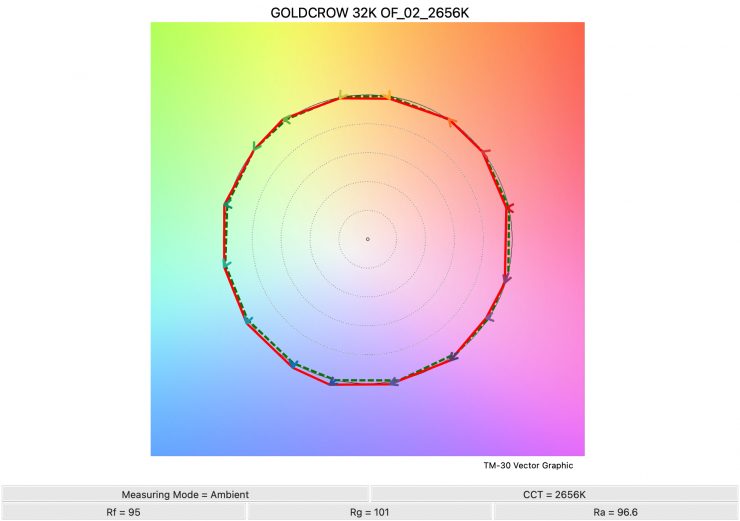
2700K 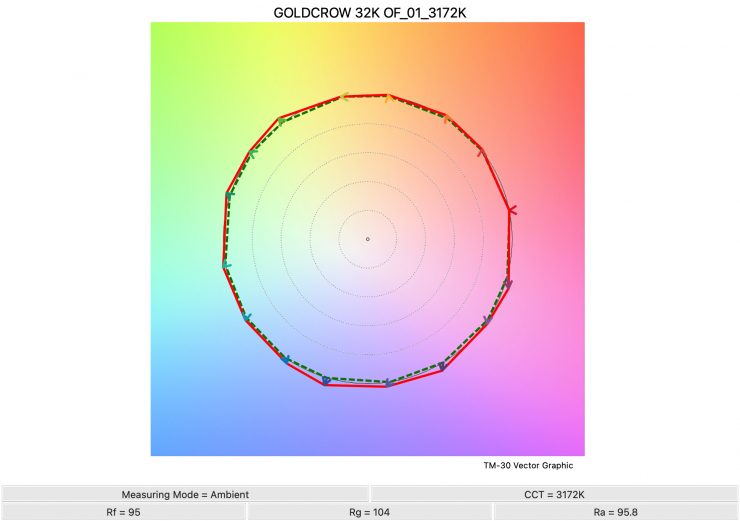
3200K 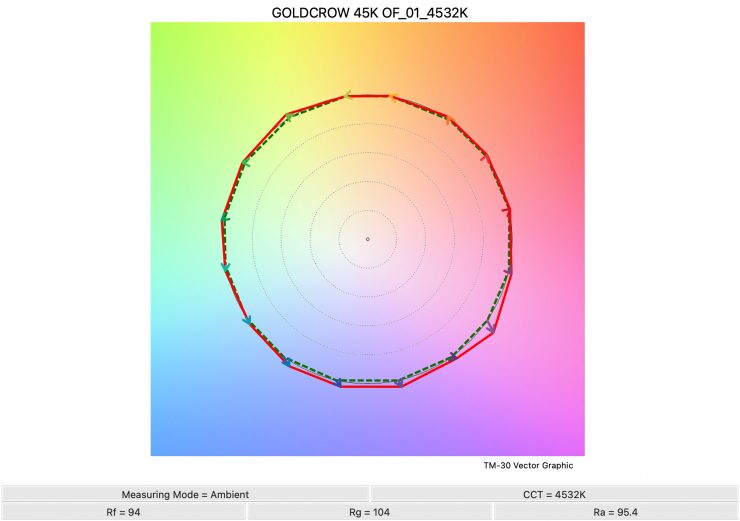
4500K 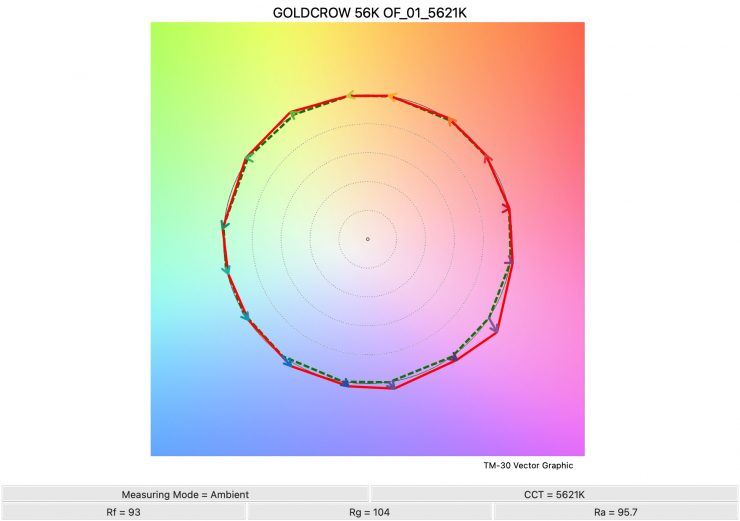
5600K 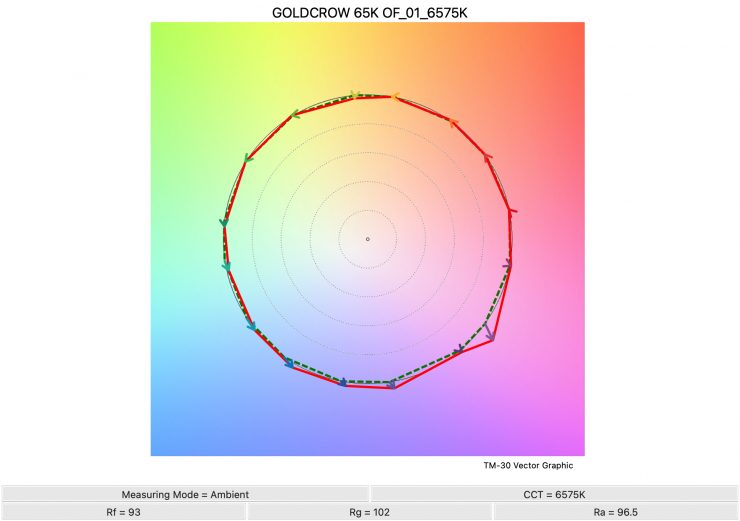
6500K
Above you can see the scores for the INKEE Gold Crow at various CCT settings. Below I have listed the figures as well.
Here are the results:
| Rf | Rg | |
| 2700K | 95 | 101 |
| 3200K | 95 | 104 |
| 4500K | 94 | 104 |
| 5600K | 93 | 104 |
| 6500K | 93 | 102 |
The TM-30 scores were ok, but you can see why the light leans magenta as it is over-saturating those colors, especially at 4500K, 5600K, and 6500K.
SSI
SSI (Spectral Similarity Index) was developed by the Sci-Tech Council of the Academy. SSI gives me the ability to set any light as a standard, or use predefined standards (such as CIE D55), and then give other lights an SSI score based on how well they will match standards such as CIE D55. This way I can measure spectral response and compare it directly against an ideal light source. This is actually a much better test than recording CRI scores.
INKEE Gold Crow 3200K (Open Face)
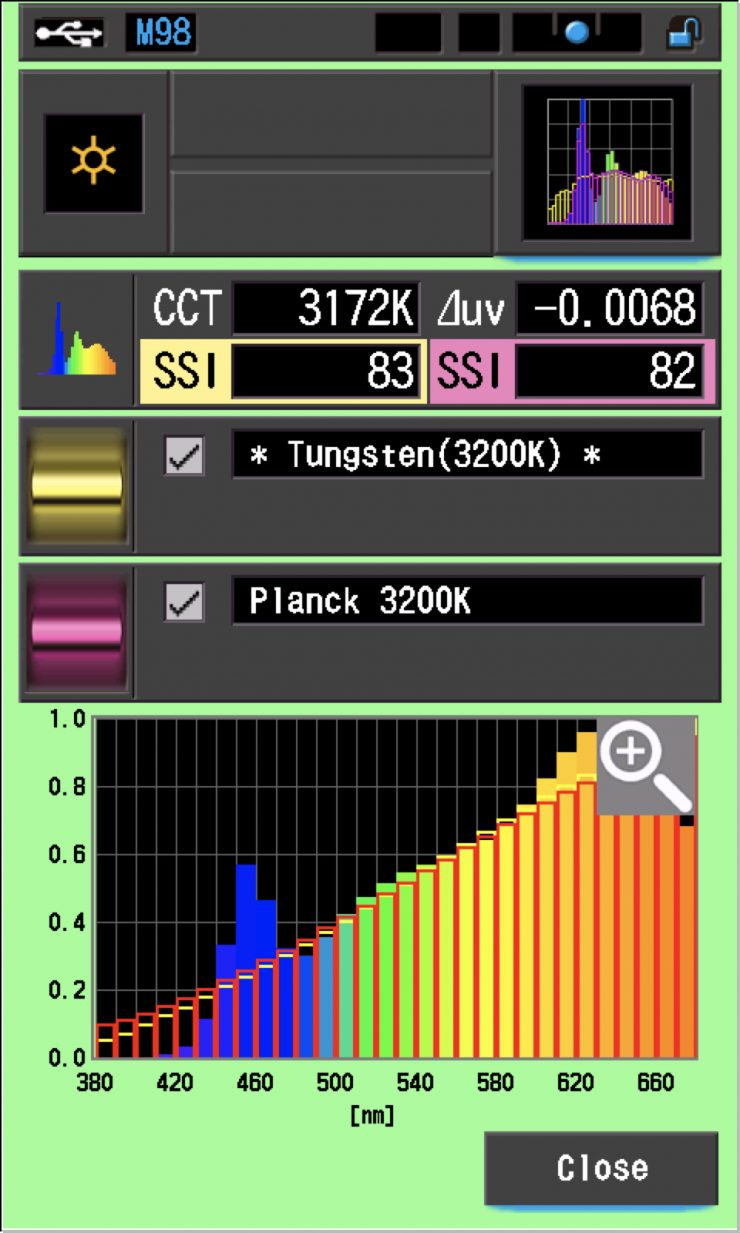
In this graph, the red bars indicate a perfect Planck 3200K source. The gold bars indicate a perfect 3200K Tungsten source. This lets us compare how close to a perfect 3200K lighting source the INKEE Gold Crow is. Any SSI score in the high 70’s, low ’80s is very good for a 3200K LED light. The results for the Gold Crow were pretty good when used at 3200K. As you can see, LED lights have a hard time replicating colors below about 450nm.
INKEE Gold Crow 5600K (Open Face)
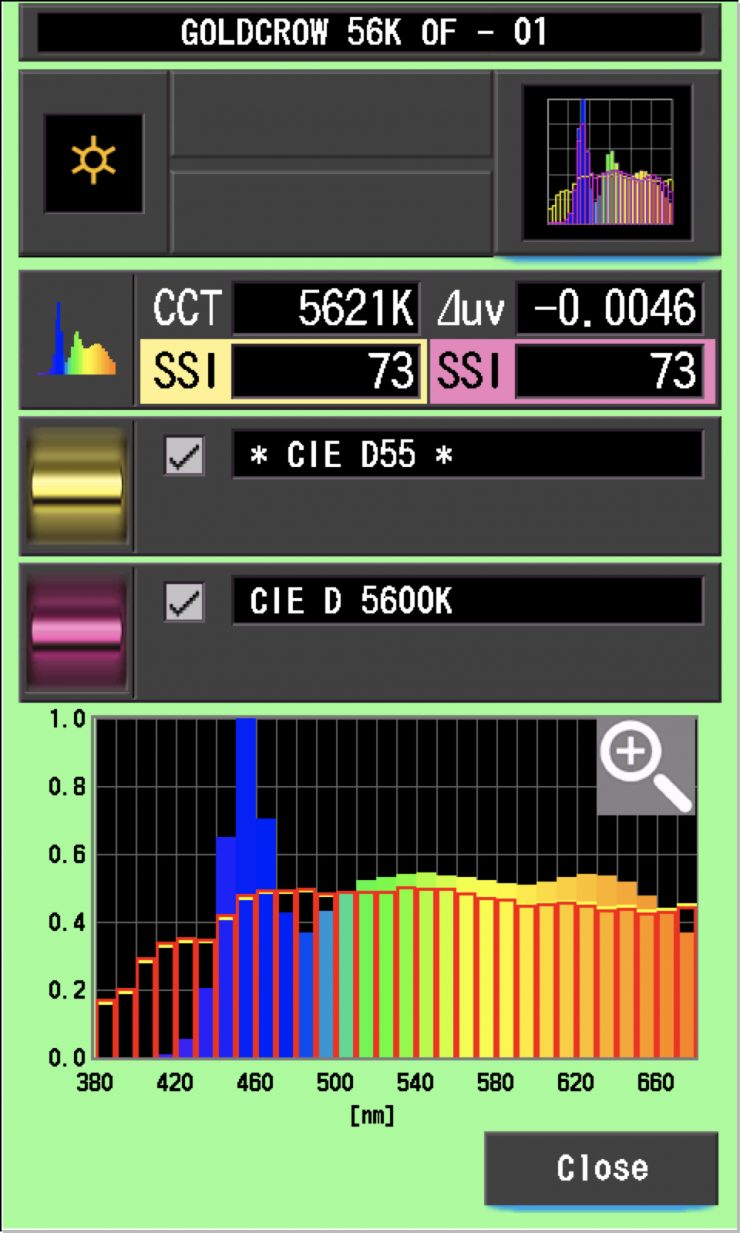
In the graph above the gold bars indicate a perfect CIE D55 source. The red bars indicate a perfect CIE D 5600K source. This lets us compare how close to a perfect 5600K lighting source the INKEE Gold Crow is. A score in the low 70’s is typical for a 5600K LED source.
The main reason we want to record SSI scores is so we can see how well they match with other lights. As an example, I wanted to see how well the INKEE Gold Crow matched the Prolycht Orion 675 FS and the ARRI Orbiter. Below you can see the results.
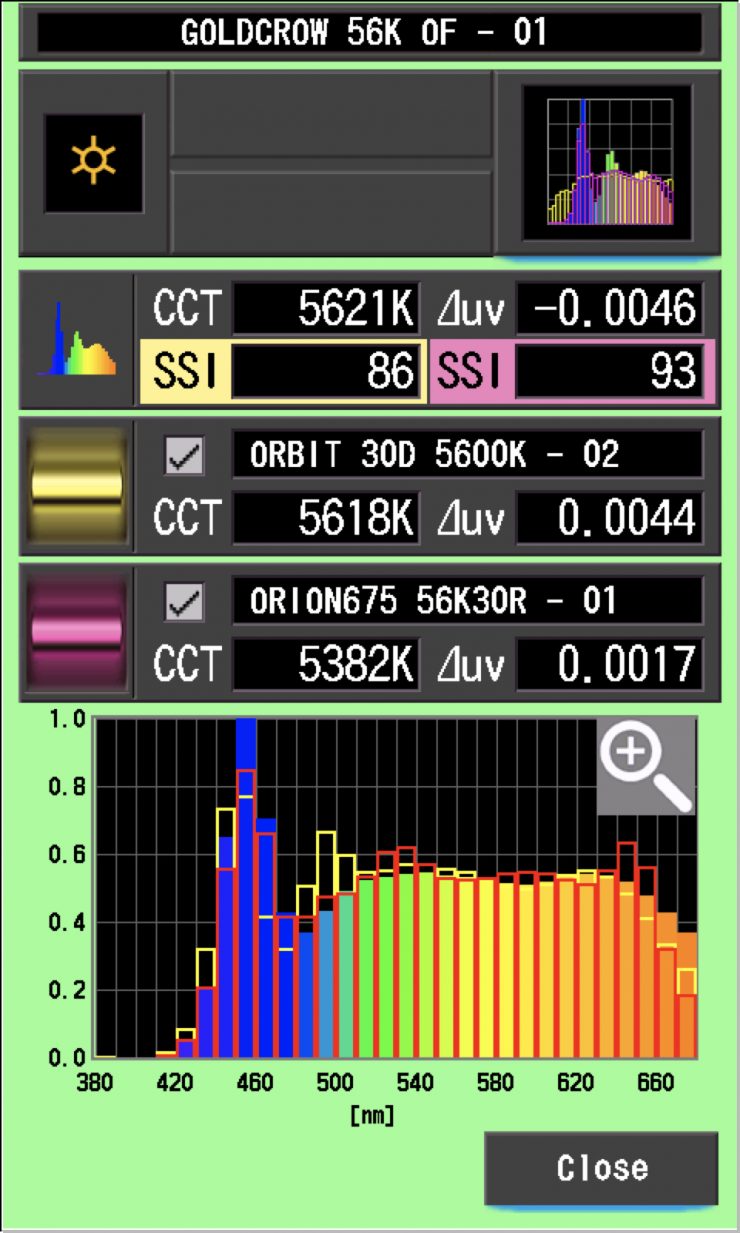
As you can see both lights are a reasonably good match to the INKEE Gold Crow. Any score in the high ’80s and low 90s would be decent enough.
As another test, I thought I would compare those same lights against the INKEE gold Crow at 3200K. Below you can see the results.
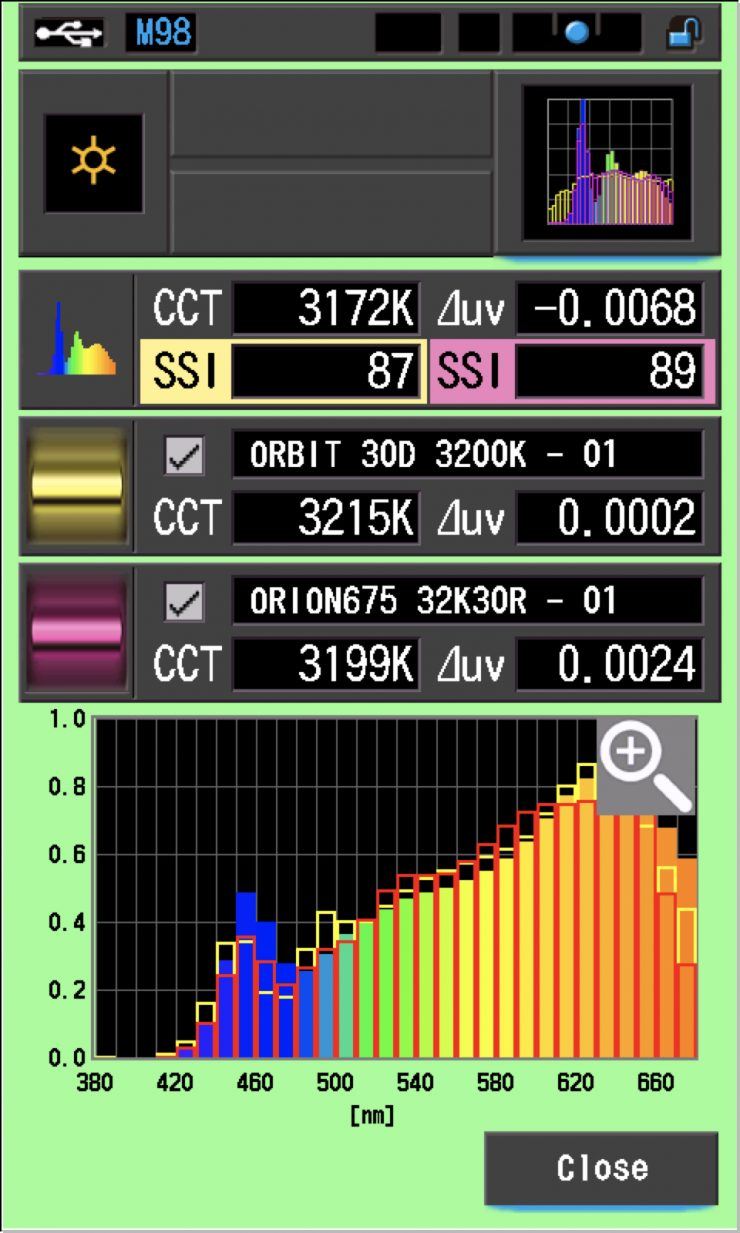
As you can see, the INKEE Gold Crow wasn’t quite as good a match at 3200K as it was at 5600K. Very few lights from different manufacturers are ever going to be an exact match.
Ok, so let’s do some more comparisons. This time I wanted to see how well the INKEE Gold Crow when used Open Face matched the light when it was used with its reflector.
As you can see, with a score of 98, the light matches very well when used both Open face and with its reflector at both 3200K and 5600K. This tells me that if I had two Golden Crows, and I used one open-face and the other with a reflector they would still work very well together.
SSI tests are a great way of telling you what lights you own or use will work well together.
Spectral Distribution
5600K
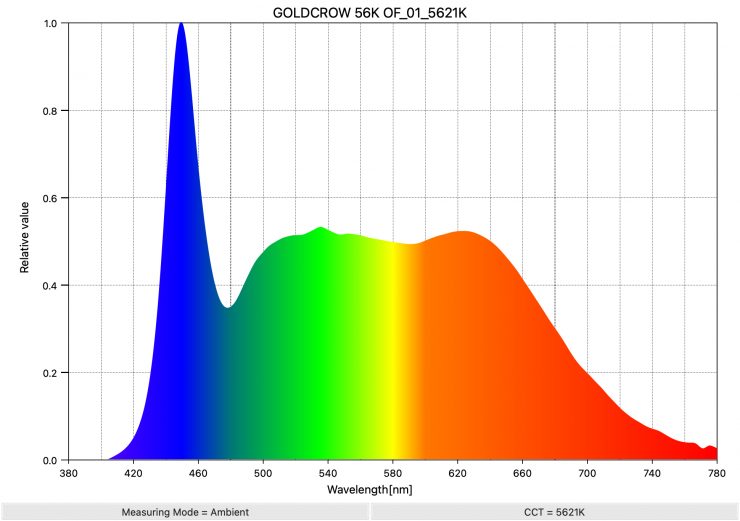
Above you can see the spectral distribution of the INKEE Gold Crow when it is set at 5600K. The spectral distribution is reasonably decent for a Bi-color LED light.
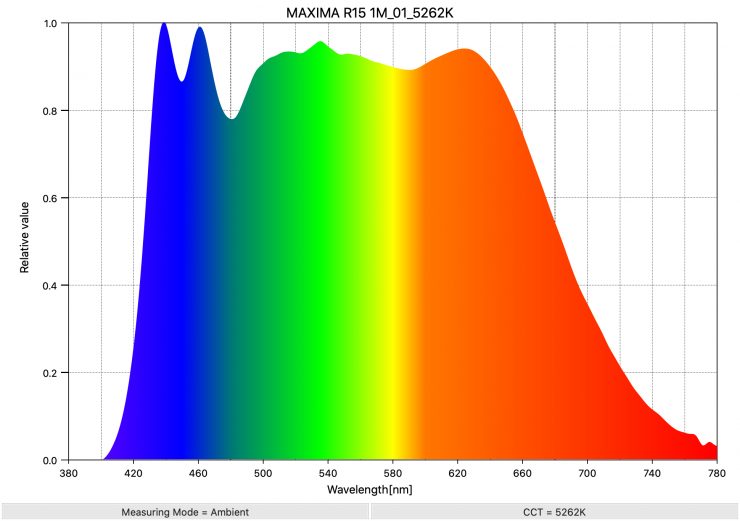
If you want to see what a really good spectral response looks like for a LED light at 5600K, above is the result for the Maxima 3.
3200K
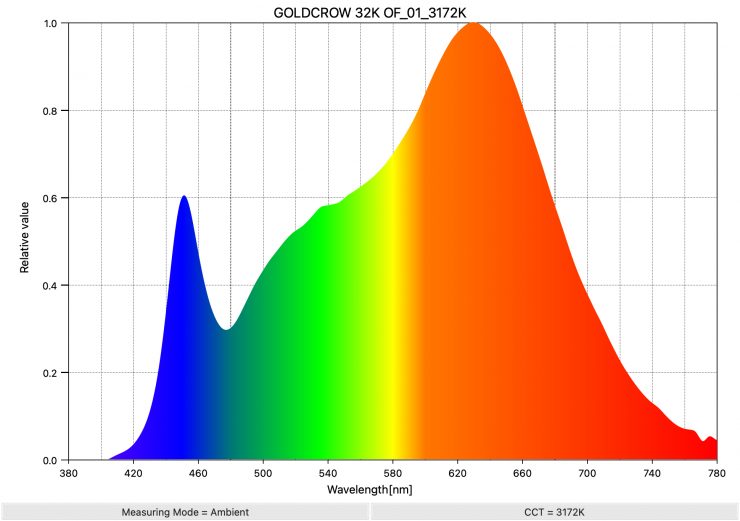
Above you can see the spectral distribution of the INKEE Gold Crow when it is set at 3200K. The spectral distribution is nice and even.
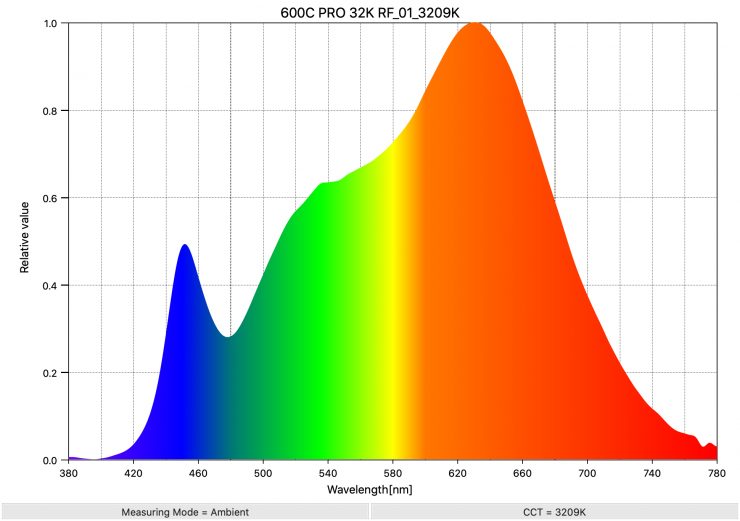
As a comparison, above you can see the spectral distribution of the Aputure 600c Pro when it is set at 3200K. The spectral distribution only has a very marginal push towards green, but overall it is very good.
Real-World Performance & Quality of Light
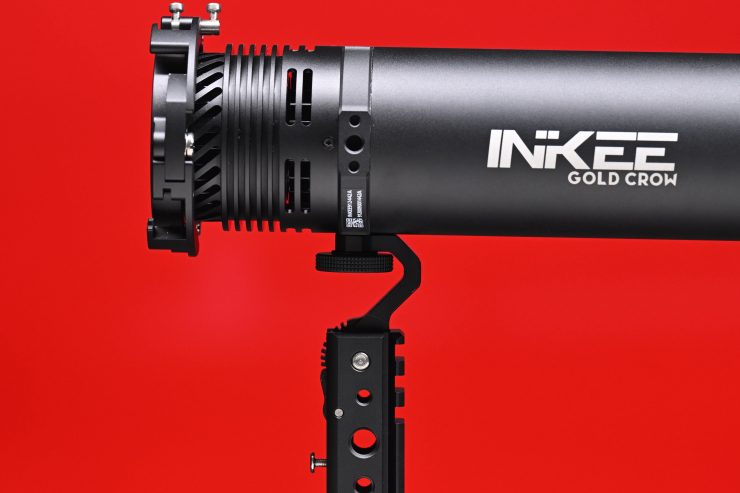
As I always say, photometric scores only tell you part of the story. So let’s find out if the scores from the INKEE Gold Crow translate into good real-world performance.
The photometric results can only give me scientific data and it is much more important for me to see how the light looks and performs. Contrary to popular belief, if you are in the business of making lights you don’t want to try and achieve perfect scores because perfect scientific scores don’t equate to a light looking good. A good light should look good to a camera because, after all, that is what is capturing the image. Cameras and our eyes see differently and ideally, you want to use a light that looks good to your camera. There’s a bit of alchemy in knowing what to prioritize in order to render colors that appear accurate, natural, and pleasing. It’s not just about hitting certain numbers.
Lighting really comes down to how you use the light and having a great light isn’t suddenly going to produce better results for you unless you know what you are doing.
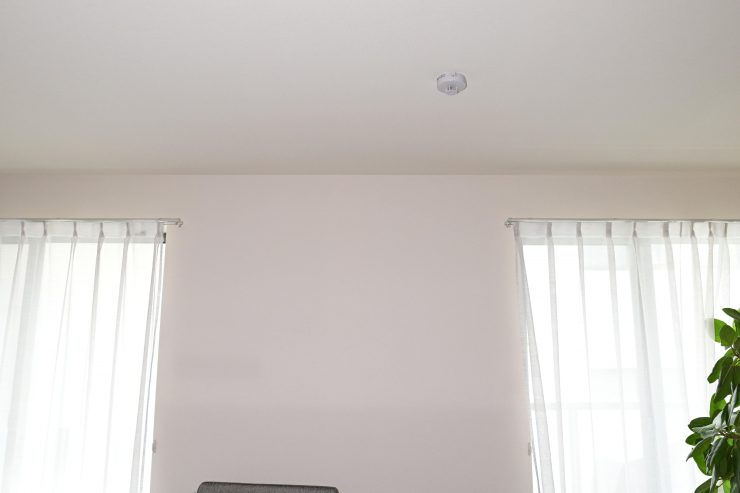
Open Face 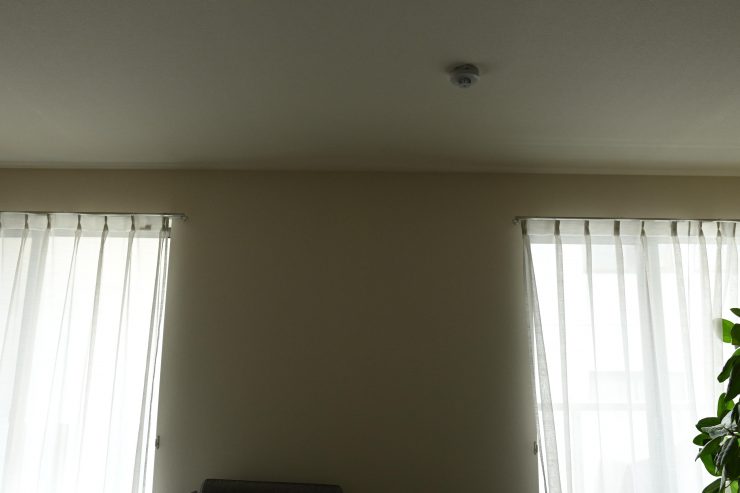
Light Off
The beam spread is nice and even when the light is used open face. The 160-degree beam spread you get when using the light open-faced allows you to create a nice broad spread of light. For a small-sized light, it is certainly capable of lighting up a reasonable-sized room.
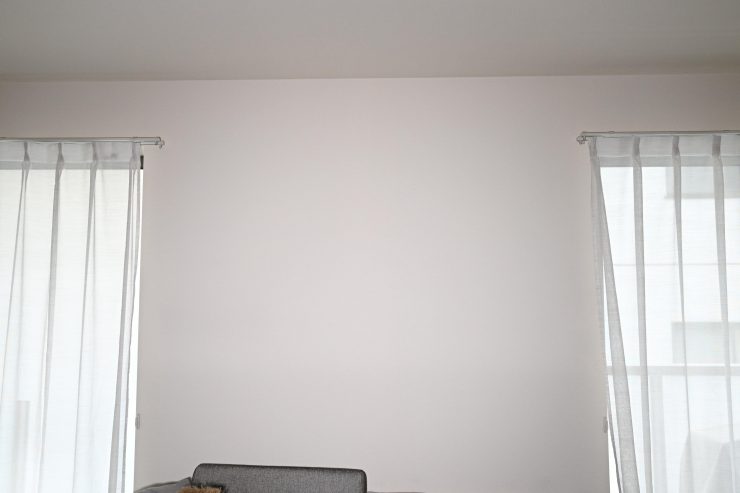
Reflector 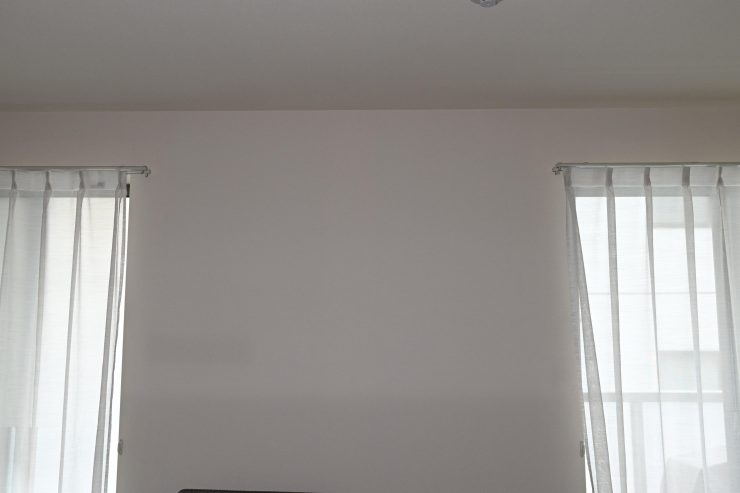
Open Face 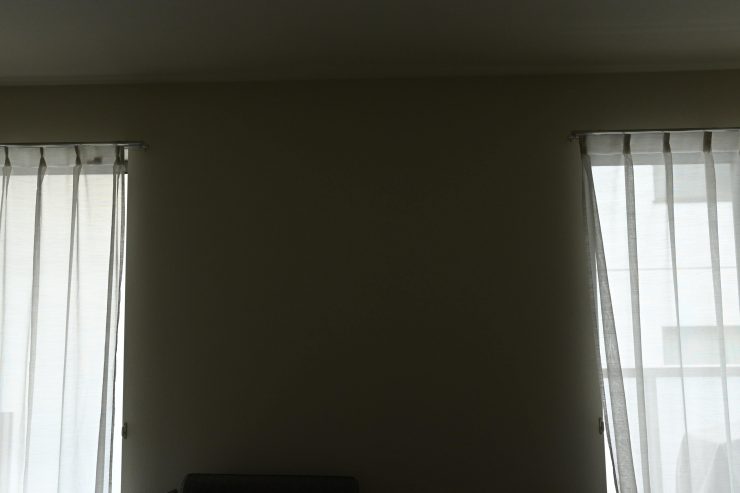
Light Off
Above you can see a comparison of the output difference between the light used with its reflector, open-faced, and with the light turned off. The light is set at a distance of 3m /9.9′ from the wall and I have kept the same camera settings for all three shots.
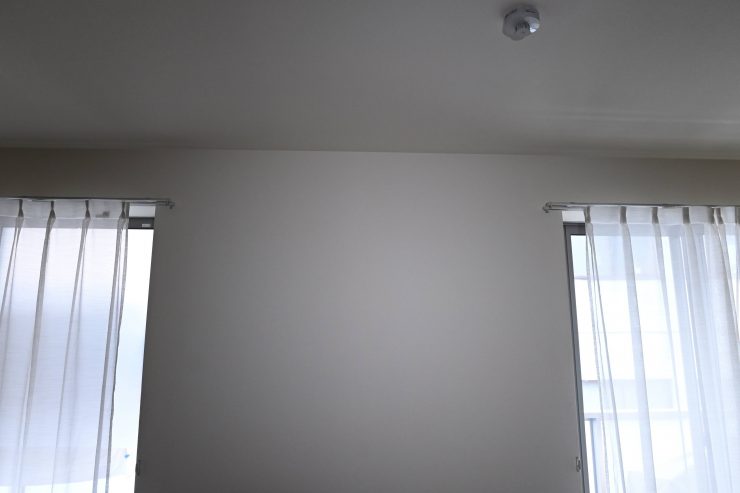
Light on
The reflector does have a slight hot spot, but it is not super apparent when using the light.
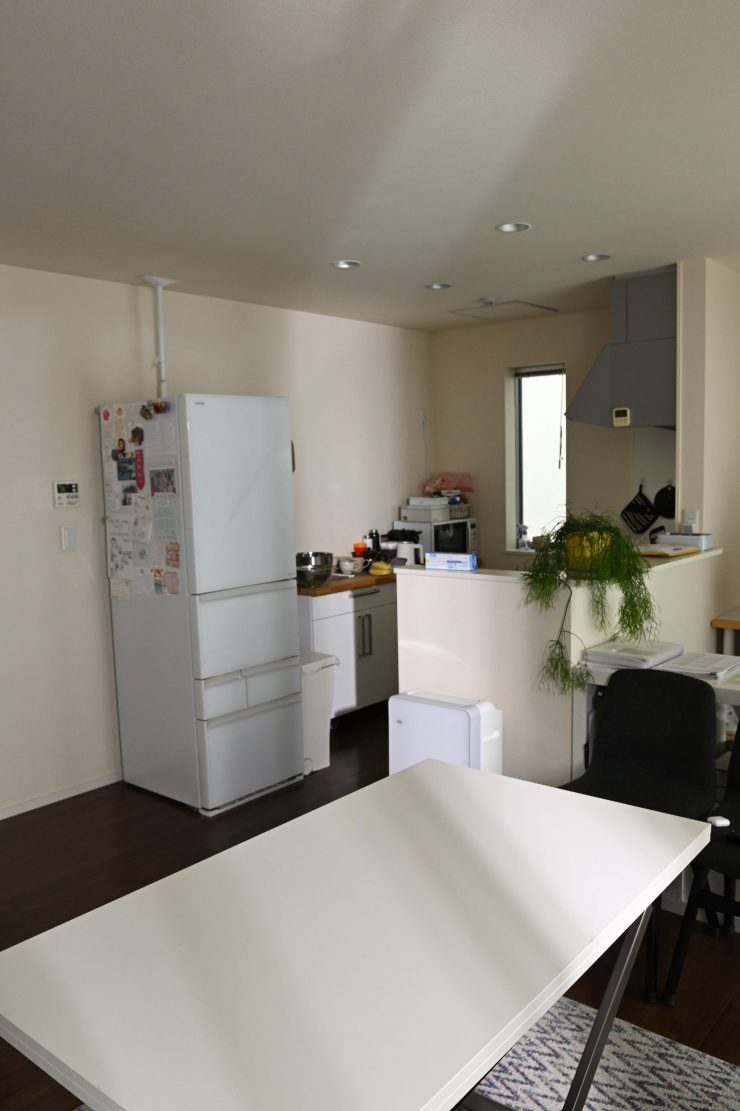
Reflector 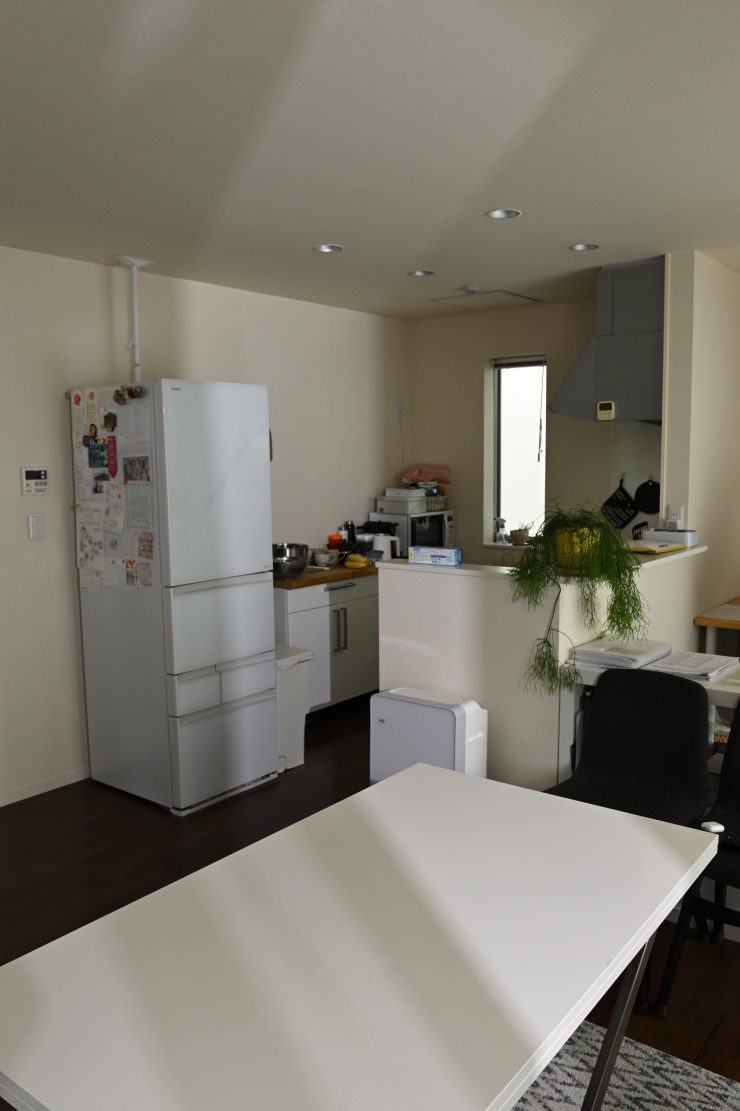
Open Face 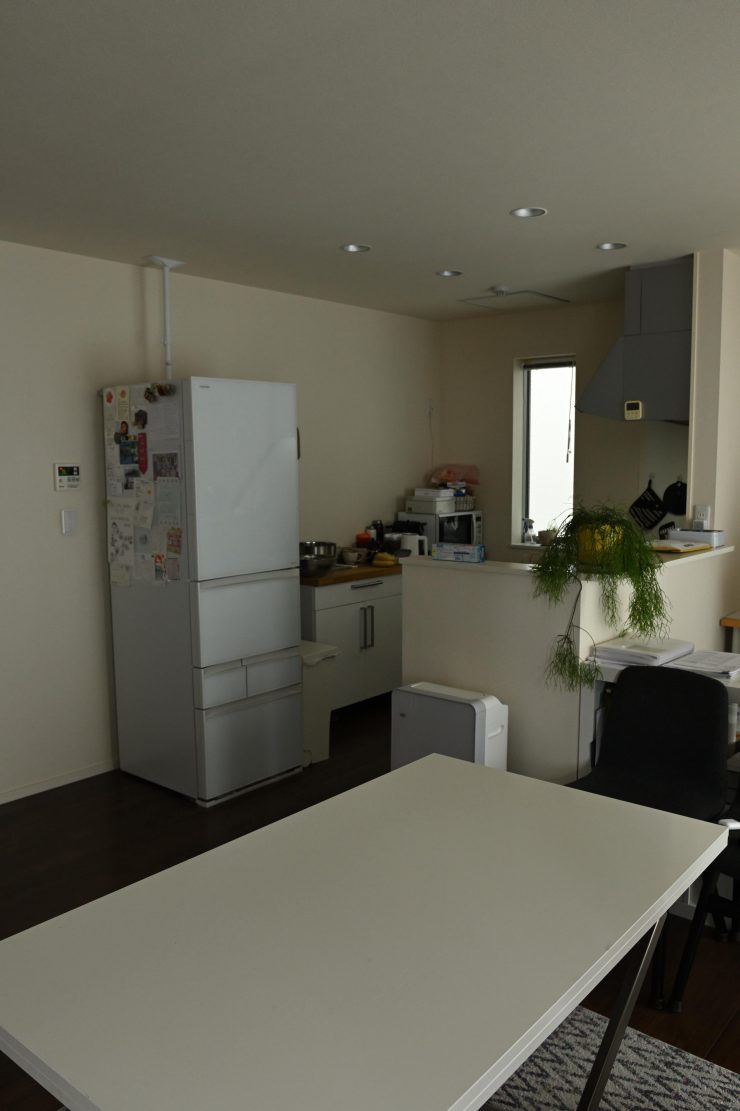
Light Off
The light does have a reasonable amount of output for a light of this size with this power draw. Above you can see a comparison with the light being used open face and with its reflector being punched through a sheer curtain from outside as opposed to the natural light.
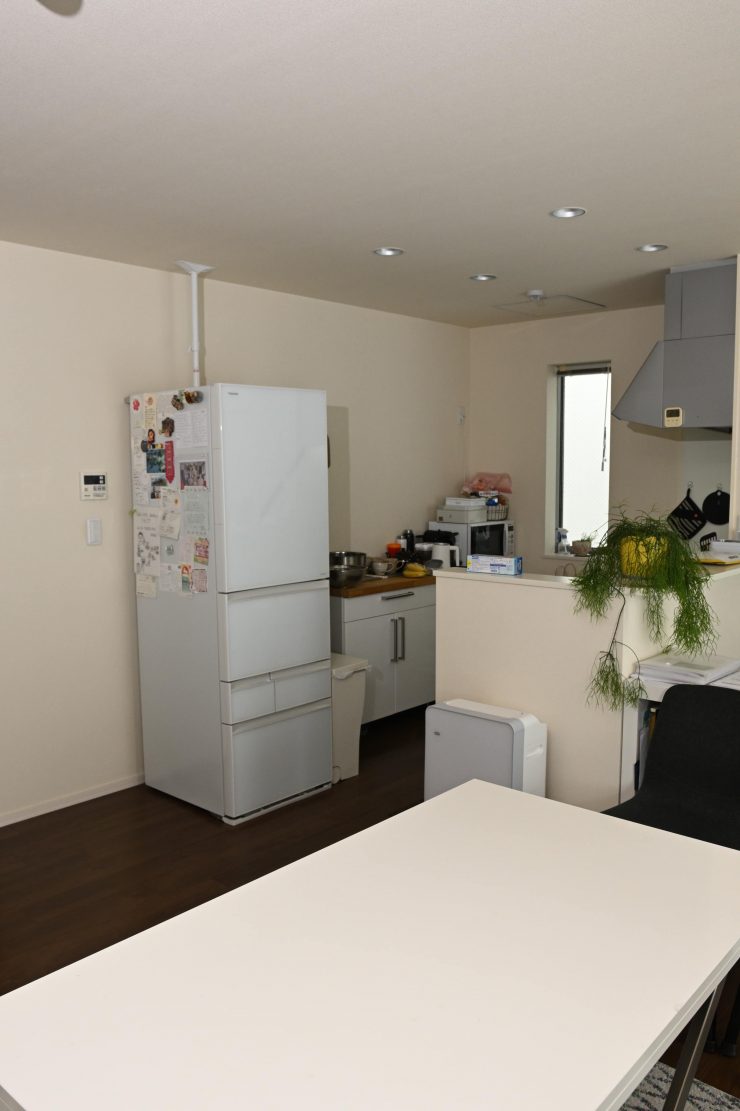
Open Face 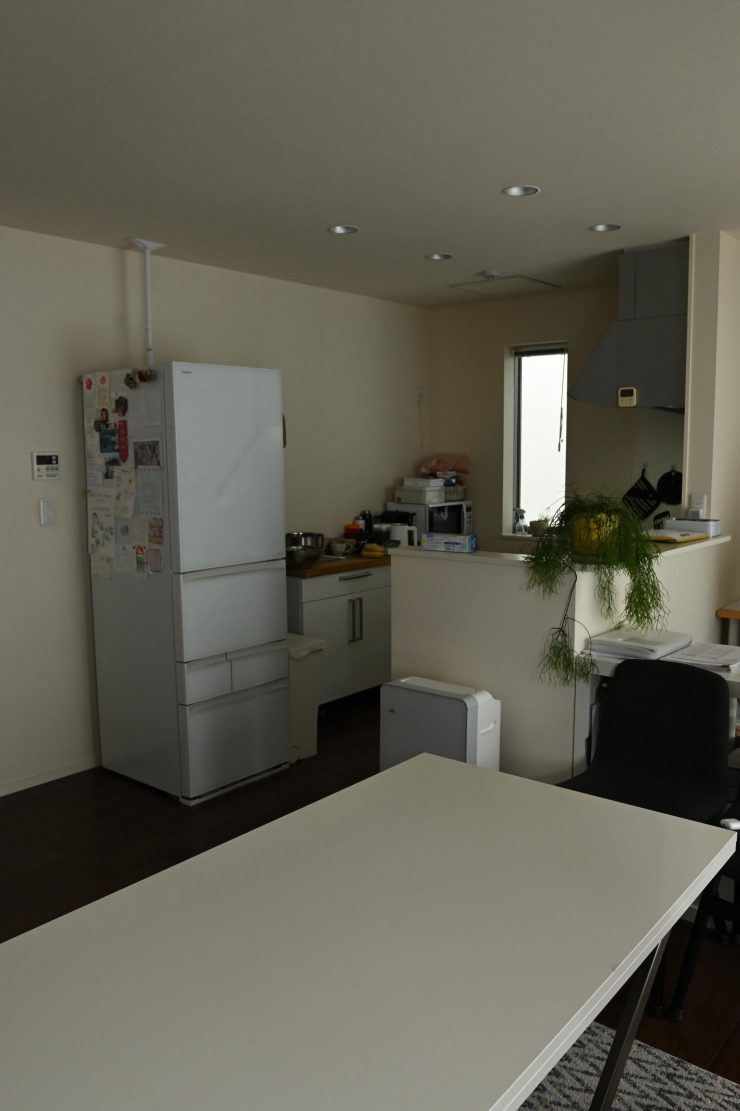
Light Off
Above you can see what the light looks like being used open-face and punched directly into the ceiling.
Like most modern-day LED lights, you can create a very soft, flattering light source using a softbox or other lighting modifier, however, you do need to be aware of the decreased output when doing this.
My other slight issue is that because the beam angle is so broad, even when using the reflector, it is very hard to control any spill.

Even when used open face the light can create nice defined shadows.
Who is the INKEE Gold Crow aimed at?
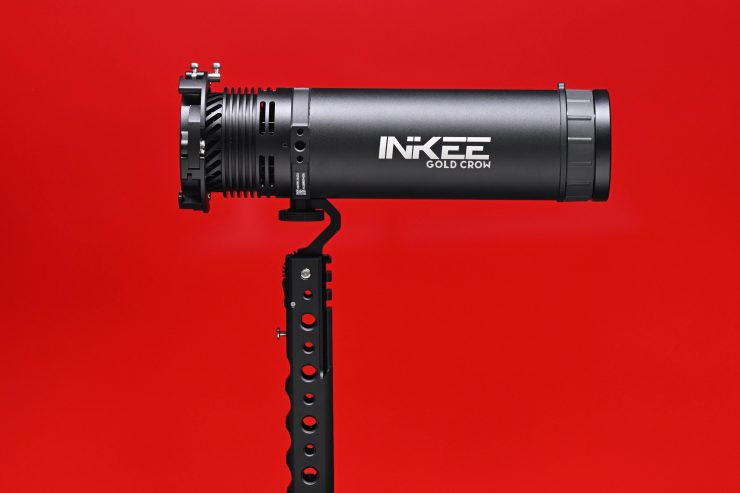
This is certainly a fixture that could be used for lots of different applications, by lots of different people. However, it is pretty clear that it is being targeted at content creators and people on tight budgets.
The small size of the light and its ability to use Bowens Mount accessories
Price & Availability
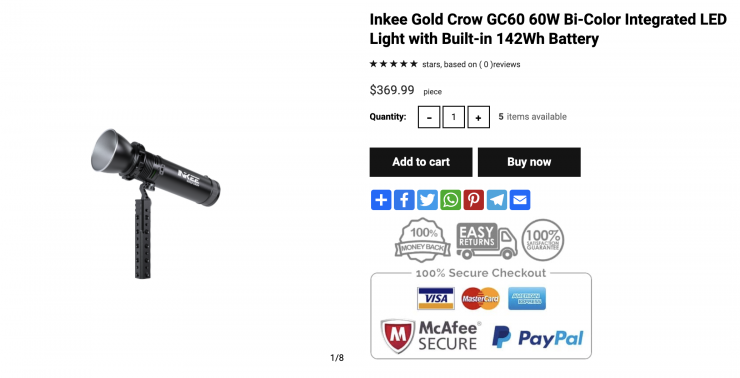
The INKEE Gold Crow is now available to purchase for $369.99 USD.
Below you can see how the price compares to some of the competition.
| PRICE | |
| INKEE Gold Crow | $369.99 USD |
| Aputure LS 60x | $419 USD |
| amaran COB 60x S | $199 USD |
| Nanlite FS-60B | $179 USD |
| Zhiyun MOLUS G60 | $249 USD |
| Sirui C60B | $174 USD* |
| Westcott L60-B | $269.90 USD |
*On special at B&H as of the 26th June 2023
I personally feel that at $369.99 USD, it is going to be a tough sell for INKEE considering what other lights are available for considerably less money. Even the amaran COB 200x S Bi-Color LED Monolight can be bought for $349 USD.
Conclusion
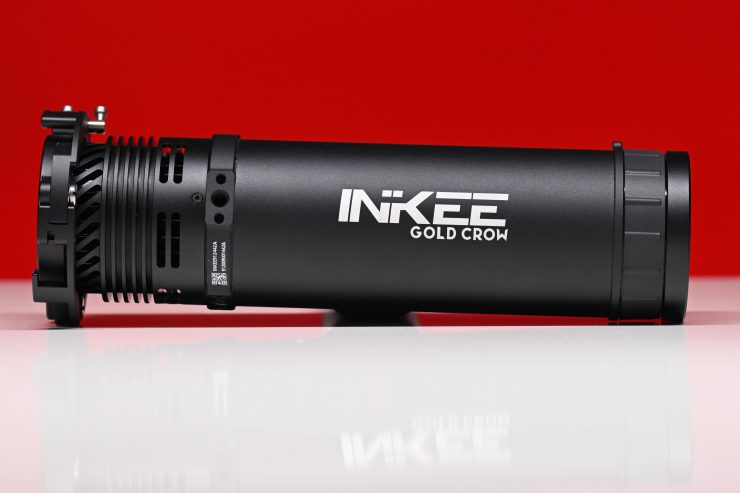
The INKEE Gold Crow has its pros and cons like any light. The build quality is generally good, and it packs a punch for a small-sized fixture. The photometric scores are solid and most importantly, consistent.
I like the ability to be able to use the in-built arms to run Bowen’s Mount lighting modifiers and the fact that the light can be used in adverse conditions. Although in saying that, you can only realistically put on very small-sized and lightweight Bowens Mount attachments. All the weight is being supported by one tiny piece of metal and I wouldn’t have confidence attaching anything to the light that weighed too much.
The ability to power or charge other devices from the light’s in-built battery is a nice touch and it certainly increases the versatility of the fixture.
Having an in-built battery is both a pro and a con. While it is nice to be able to power the light without hooking it up to anything if you want to power it via mains you need to hook it up and run it via a compatible USB-C device USB-C or the USB-C wall charger that comes in the kit, but that is far from ideal in a lot of scenarios.
On the negative side, the mounting system needs to be improved, and the UI and operating interface can certainly be confusing. The very wide beam angle when the light is used open face and with its reflector could also be viewed as a negative as there is no way of shaping or controlling the spread easily. I do also feel like the light is slightly overpriced considering the competition that is out there. For a brand that not a lot of people would be familiar with, you need to either have an exceptionally good product that offers a lot more than its competition, or it needs to be considerably cheaper. Now, you should never judge a book by its cover, but that is the reality INKEE faces.
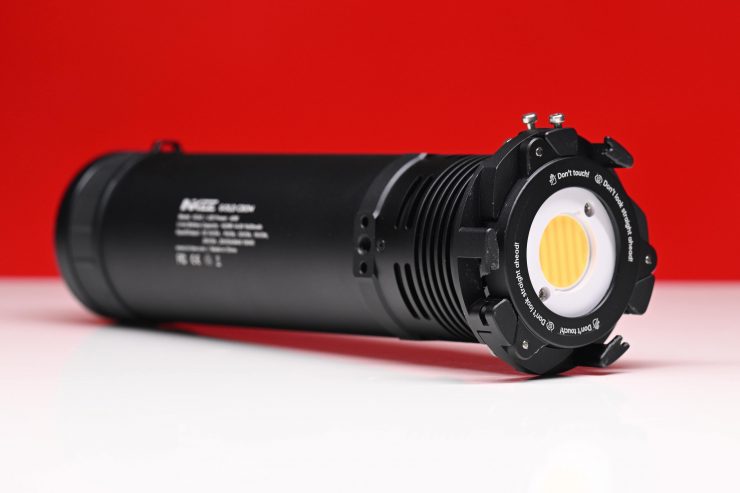
While the output is decent, once you start to diffuse the light when using it open-faced, then you lose a lot of it. When combing this fixture with a softbox or lantern it is going to have to be placed fairly close to your subject unless you are in a very controlled environment.
The INKEE Gold Crow, despite some of its flaws, is a very capable fixture. While it doesn’t excel in any one area, it is solid across the board, but it will face very stiff competition from my well-established lighting brands.
Technical Specifications
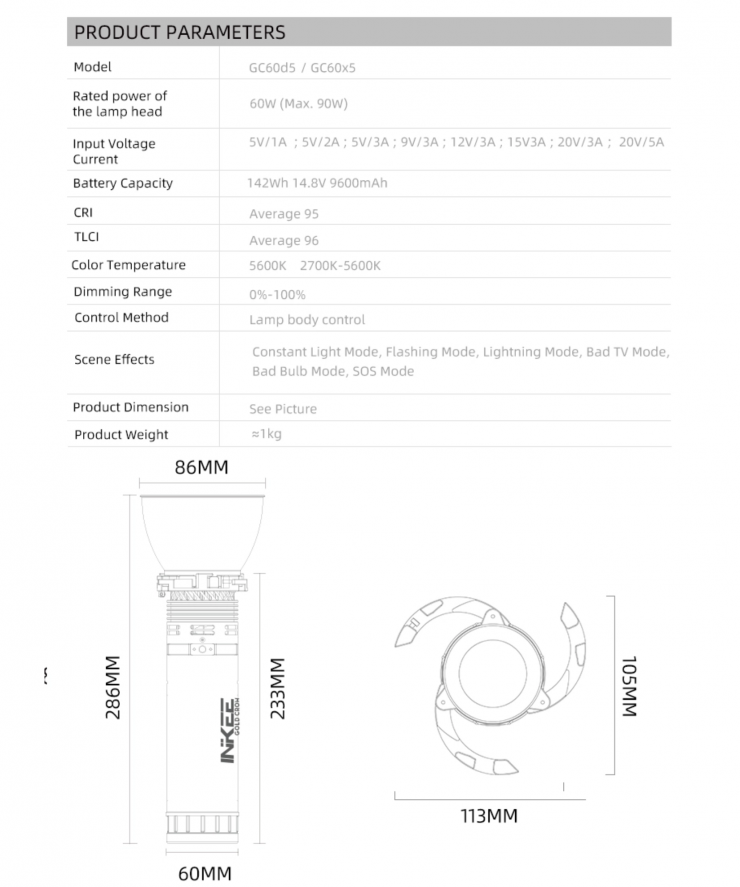
Like what we do and want to support Newsshooter? Consider becoming a Patreon supporter and help us to continue being the best source of news and reviews for professional tools for the independent filmmaker.

